Oak Park Illinois – Hemingway and Frank Lloyd Wright
About a month ago I found myself with a free day in my one of my all time favourite cities – Chicago. It really is my kind of town. The modern architecture never ceases to keep me spellbound, particularly these two amazing apartment buildings by Mies van der Rohe. Doesn’t it look like the cars on the bottom dozen stories could just back off into space? However, instead of spending the day in the loop or at the Field Museum, I decided to visit a Chicago suburb, Oak Park, Illinois that was home to two great American geniuses, Ernest Hemingway and Frank Lloyd Wright.
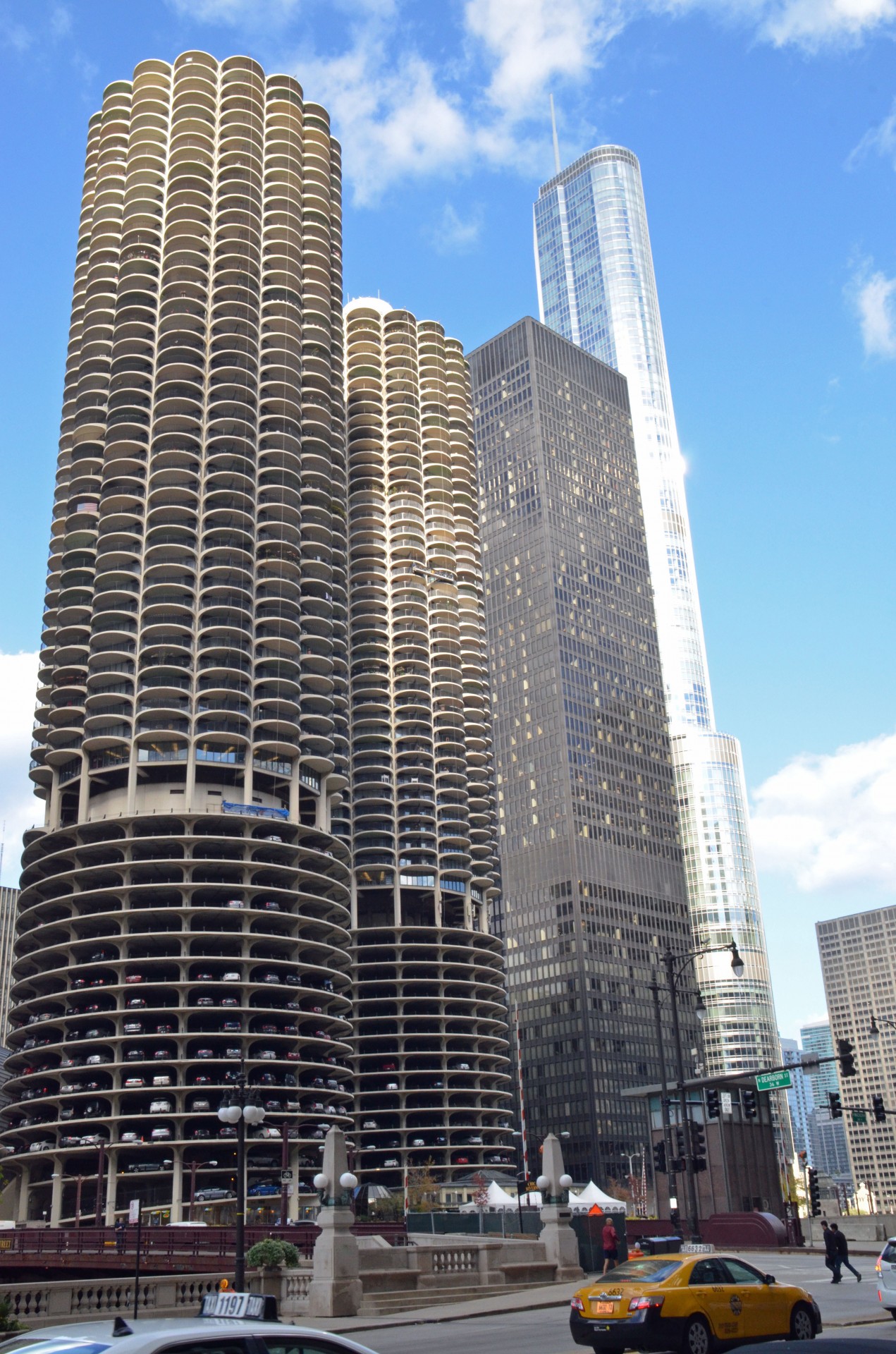
Both Hemingway and Wright are controversial figures for almost the same reasons – they had, to put it mildly, problems with women. Not that they were violent wife beaters or orgiastic satyrs, but they were serial philanderers, both married three times with other flings along the way which is enough for some people to deem them misogynists. Being married three times myself, I think that’s not necessarily a fair indictment. To me they should be judged on the works they have left behind and not whether or not they were choirboys and today I am about to do exactly that in the case of Wright who has left a body of work in an astonishingly small area. Hemingway I have already judged to be a true genius from the time I started reading his Nick Adams short stories as a young teenager. Here was someone I could connect with; a boy turning into a man fishing and hunting the woods and waters of the Michigan Northern peninsula. Substitute Northern Manitoba for Michigan and me for Nick and viola I had a literary hero based on myself.
Chicago has a great transit system based in part on its legendary elevated railway or that ubiquitous crossword puzzle answer ‘el’. I hopped on the Blue Line at North Clark and counted out the fourteen stops to Oak Park, passing through Al Capone’s old stomping .grounds of Cicero and numerous other nondescript neighbourhoods before alighting at South Oak Park Avenue. Frankly this area wasn’t much of an improvement from the rest of the suburbs I’d been passing through. I consulted a city map posted nearby and realized I should have taken the Green Line which would have put me much closer to the historic portion of Oak Park I was interested in seeing. No big deal; I headed north on Oak Park through fairly deserted streets towards Hemingway and Wright territory. Even though it has a population of over 50,000 Oak Park actually calls itself a village. Seems to me that is a bit of reverse psychology from that which sees places with less than 10,000 residents call themselves cities. There’s something cozy and secure about living in a village as opposed to a big scary city and I suppose Oak Park is trying to define itself as something different from the other 134 incorporated municipalities in Cook County. It’s definitely starting to look that way as I cross under the Green Line and there are more and more people on the wide sidewalks enjoying a late morning latte or whatever. They don’t look the types that would just have a coffee. I know I have arrived at the right area because I’m told so by this sign.
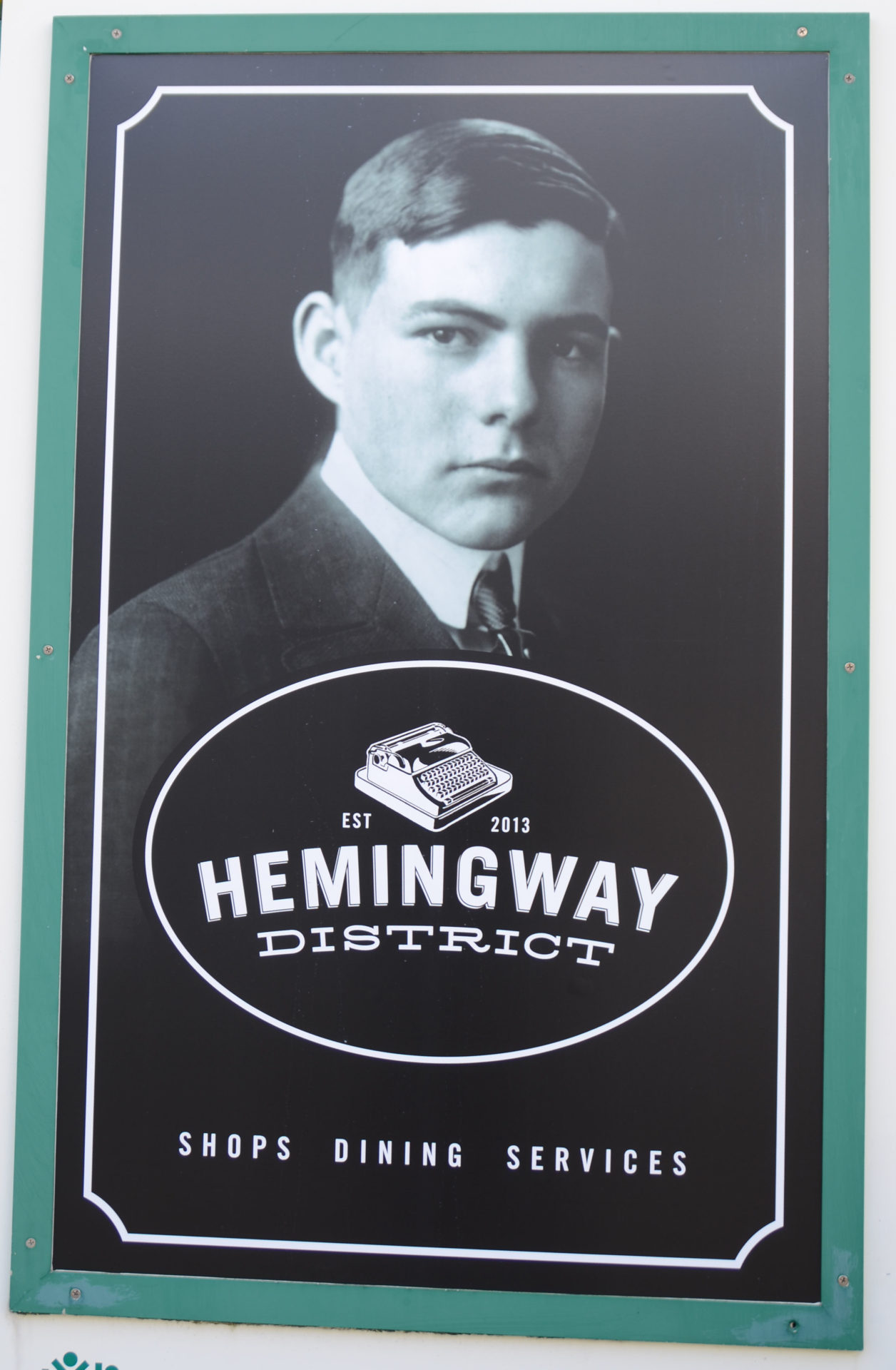
That’s a very young and pardon the ridiculous pun, earnest looking Ernest. Approaching Oak Park and Lake the street is framed on both sides with very handsome buildings that house galleries, restaurants and antique shops – all the things that are de rigeur for a trendy hipster neighbourhood.
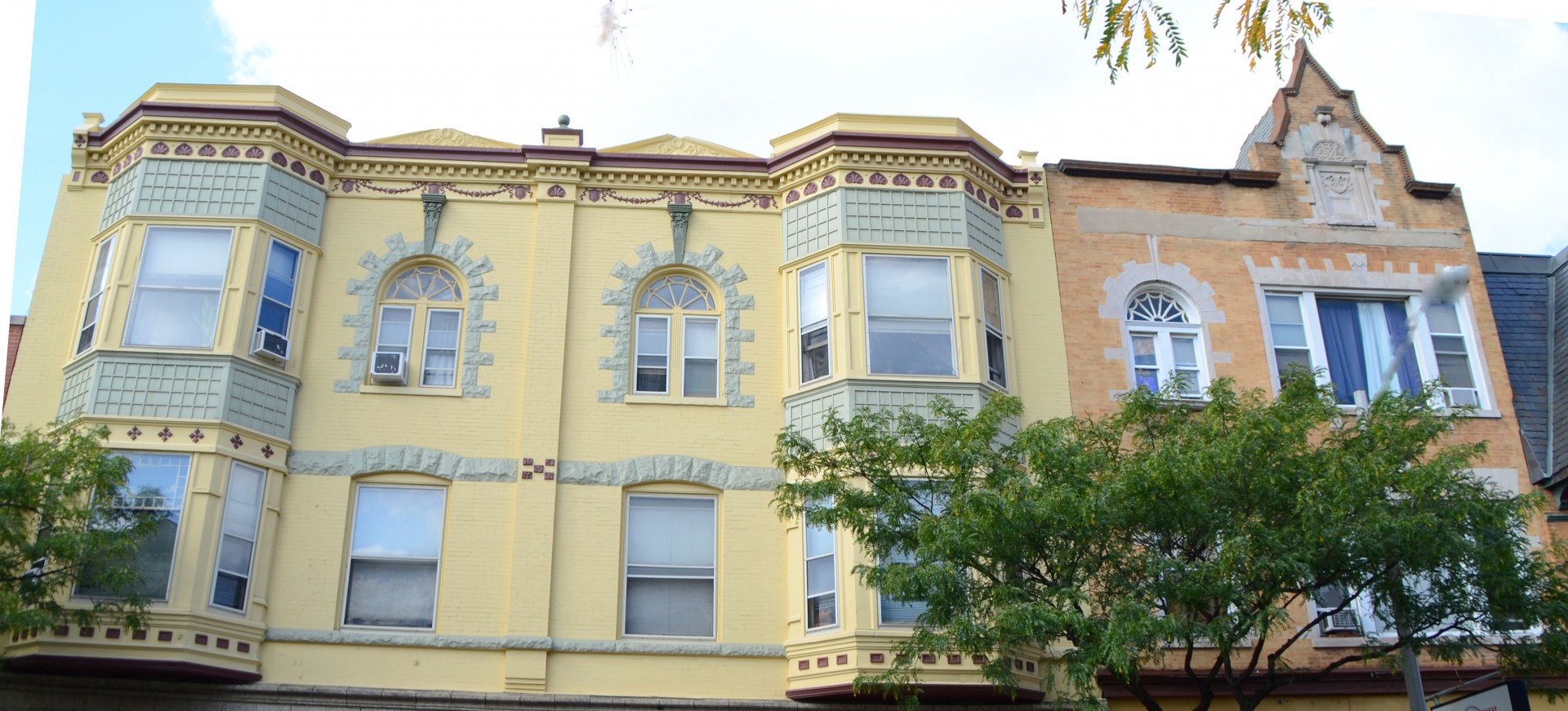
At the junction of Oak Park and Lake is the first really unusual building, a Prairie Style commercial building called Scoville Square which at first doesn’t really get my attention until looking at it more closely I realize it has an almost pagoda like roof and very unusual entrance. It’s not an easy building to photograph because you can’t get far enough back to really capture it without almost a fish-eye lens so I borrowed this photo to give a better picture.
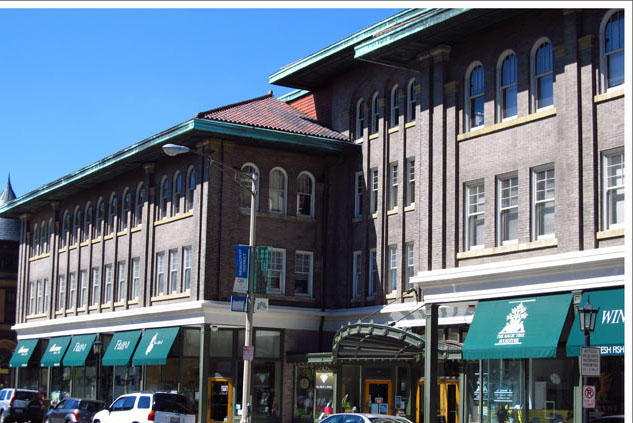
Across the street from Scoville Square is Scoville Park where I found this very fine WWI memorial, something you seldom see in U.S. cities where Civil War, WWII or multi-war memorials are far more common. That’s Lady Columbia, looking very similar to her likeness on the National Memorial Cemetery of the Pacific in Honolulu and famously used in the opening shots of the original Hawaii 5-0 series.
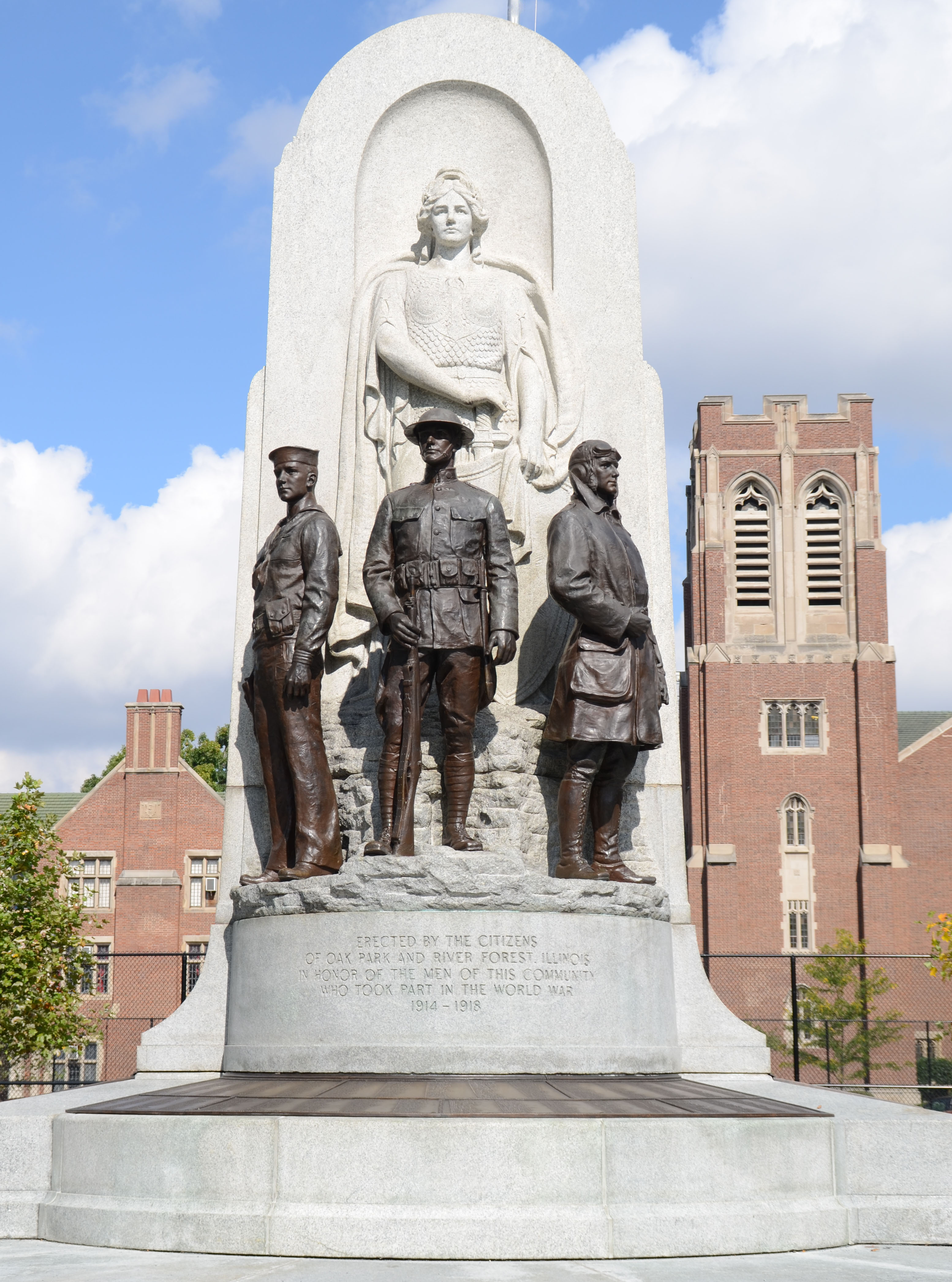
Among the more than 2,500 names is that of Hemingway, E.M. who as any Hemingway aficionado knows, served briefly as an ambulance driver in Italy during that war. Heading west on Lake towards the tourist bureau I passed the first Frank Lloyd Wright building, the Unity Temple which is one of his few public buildings in Chicago and because it was the first major edifice to be built entirely of reinforced concrete, accepted by many as being the first ‘modern’ building in the world. At least that’s what the Wikipedia article says, for what that’s worth. I didn’t stop because, to be honest I was on the other side of the street and didn’t know it was a Frank Lloyd Wright building until I picked up the Wright Walking Tour brochure from the tourist bureau. Here are public images of the exterior and interior in case you want to decide for yourself if it’s worth visiting. The interior looks a lot more compelling to me than the exterior. Reinforced concrete has never been my idea of a great building material and in fact after just over 100 years later in 2009 was listed as one of America’s Most Endangered Historic Places by the National Trust for Historic Preservation.
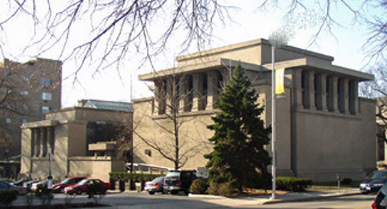
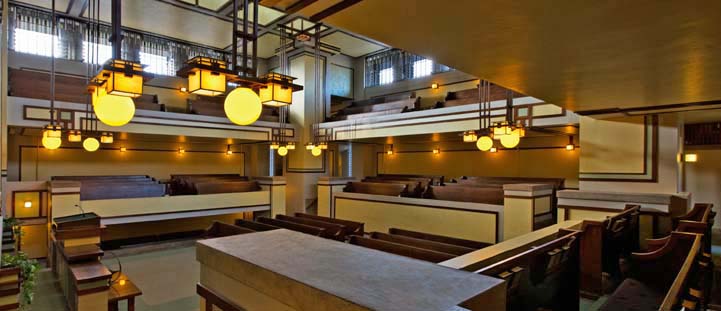
So I made it to the Oak Park tourist office and found out I was only steps away from the start of a walking tour that would take me to the Wright studio and past many of the architect’s finest private homes, all in an area of only a few blocks. I picked up the brochure (the closest on line map I could find is here) and headed toward Forest Avenue, however, before starting I want to write a bit about Frank Llloyd Wright and how I came to be fascinated with him and his work. For a long time I just couldn’t get what people saw in the Prairie School of Architecture or the Arts and Crafts Movement which was its British predecessor. While I certainly appreciated the decorative arts aspect of both styles, it was the architectural side of things that turned me off – too many straight lines, rectangles and squares. It certainly didn’t help that I was growing up in a country where there was next to no chance of actually seeing Prairie style houses – all my knowledge came from books. So Frank Lloyd Wright was really not on my radar screen until my interest was awakened by a jigsaw puzzle of all things. Every winter I order a half dozen or so jigsaw puzzles to while away the long hours. Included in the order are always a few art based puzzles and one year I ordered a puzzle based on this design by Wright.
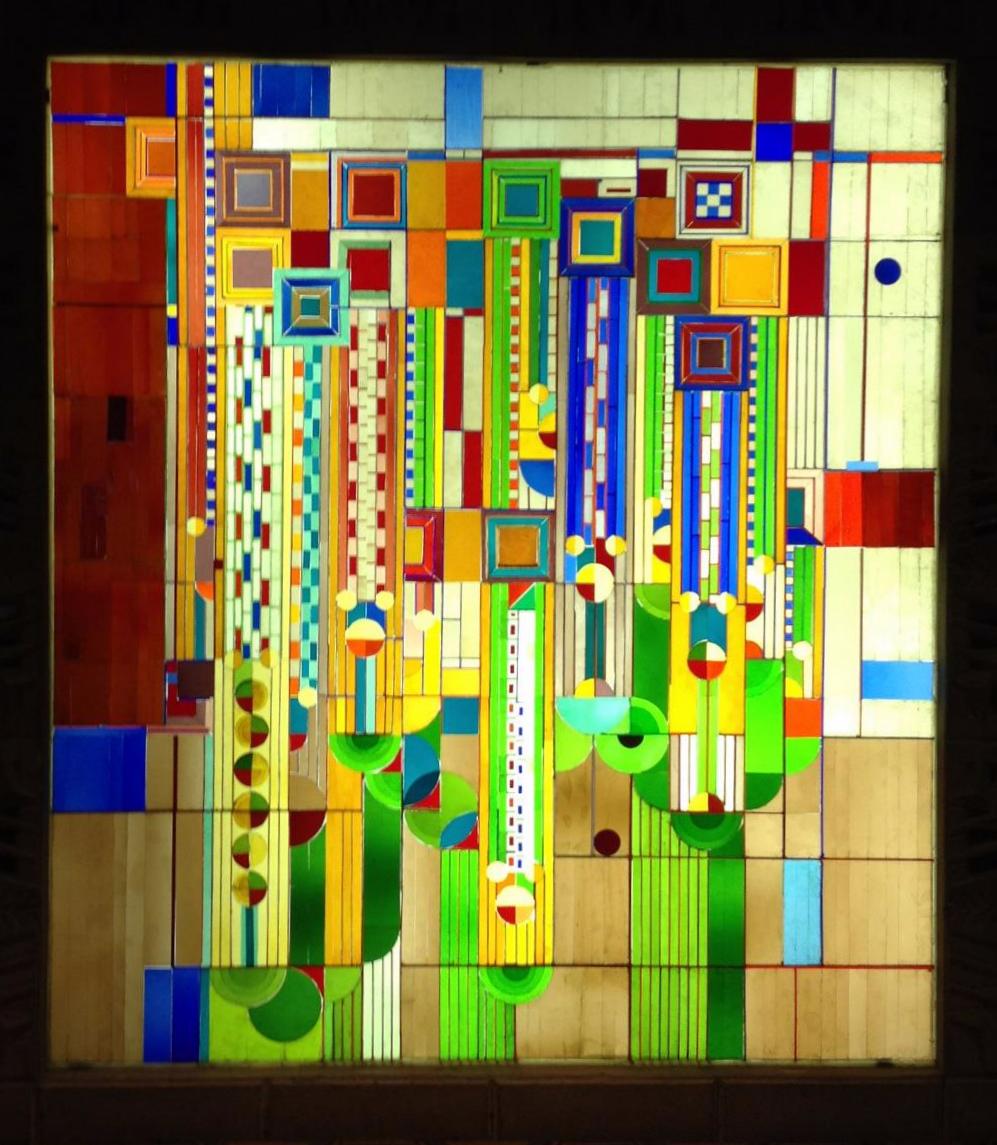
I had no idea Wright worked in this medium and discovered that he produced dozens of beautiful stained glass pieces. My interest in stained glass dates back all the way back to my first visit to Europe as a young teenager when I was absolutely blown away by the stained glass in the Gothic cathedrals I visited. I still have a vivid memory of first seeing the rose windows in Notre Dame in Paris and being simply stunned into silence by their majesty and beauty.
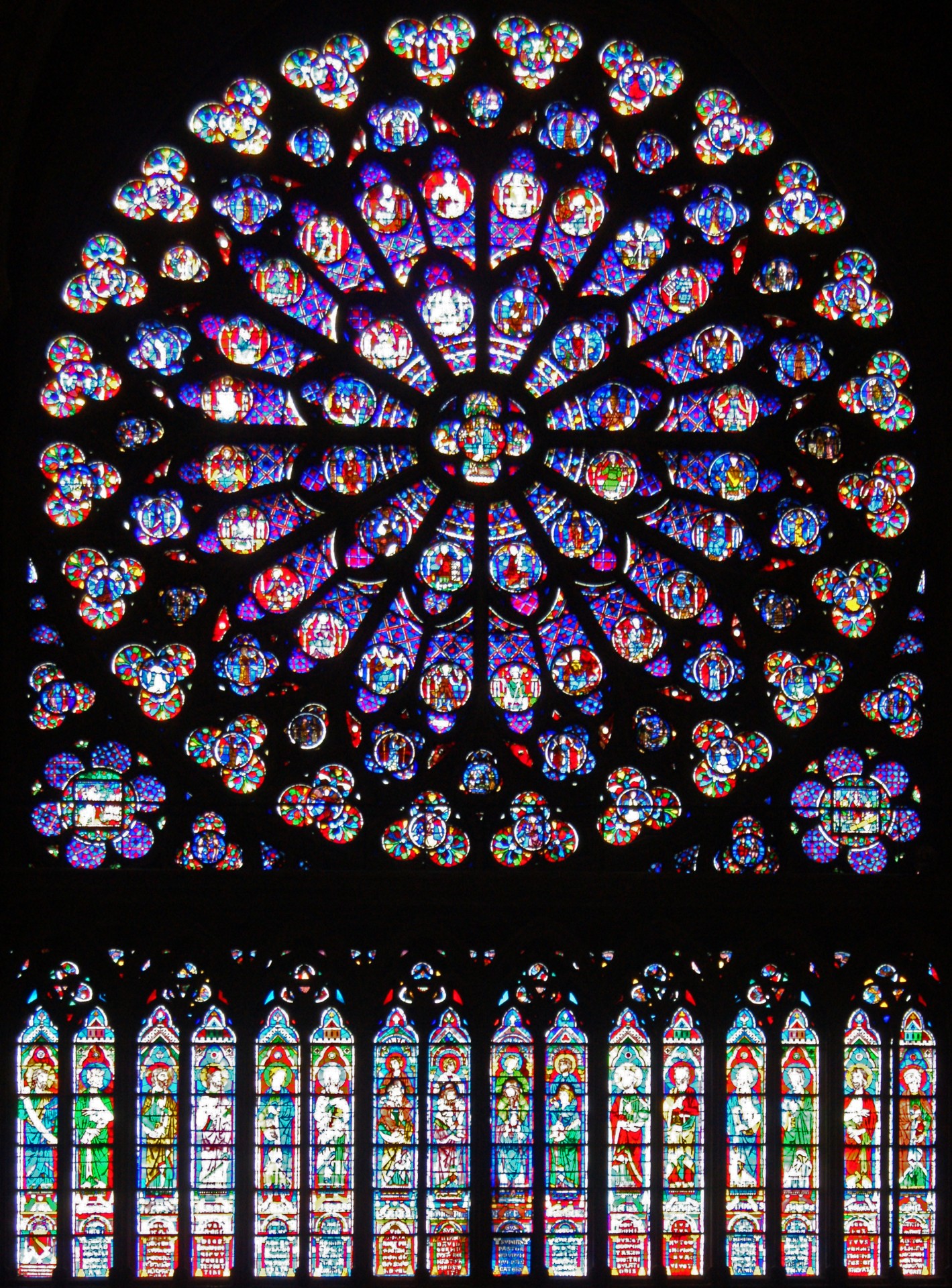
Not long after it was the works of Louis Comfort Tiffany and others that attracted my interest and confirmed that the making of great stained glass was not a lost art as they will tell you when you visit the European cathedrals. It may not be the same process, but the results are pretty damned good. Here are a few pictures I took of Tiffany’s work just in the last year. The first is a parakeet themed panel from the Museum of Fine Arts in Boston.
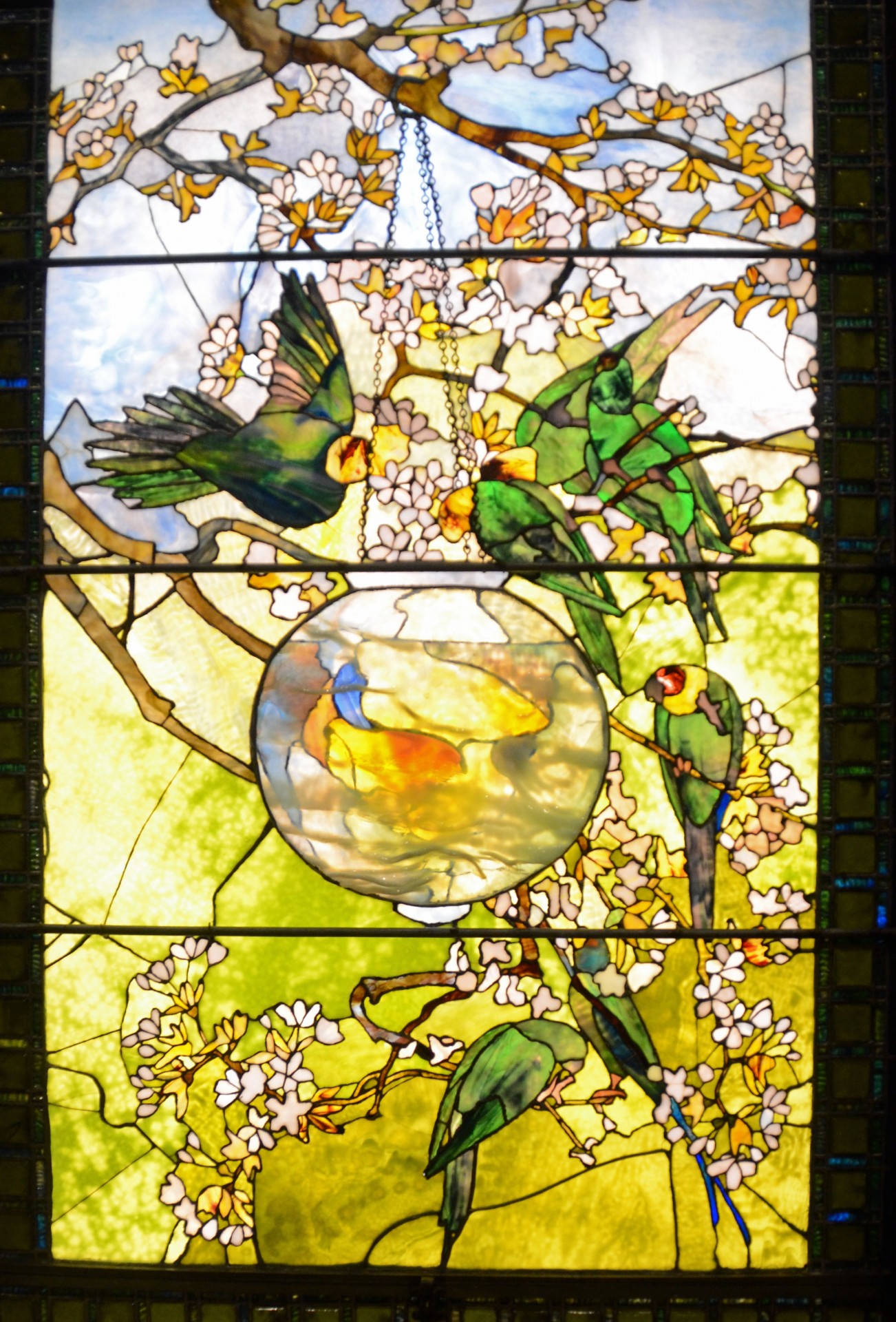
The second is a glass ceiling (yes ladies there really is such a thing as the glass ceiling, but you wouldn’t want to break through this one) from the Nemacolin Resort near Pittsburgh.
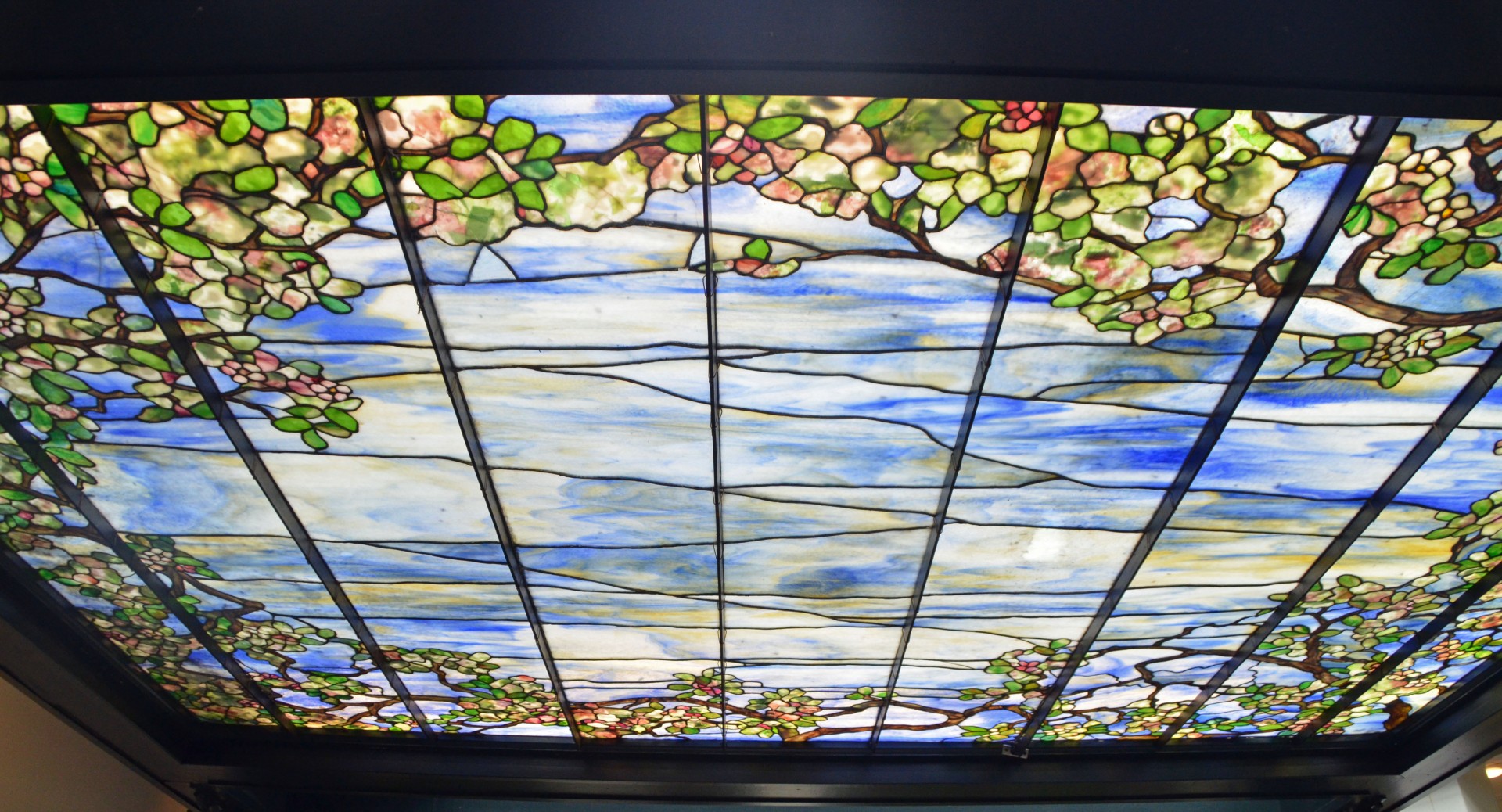
And the third is this Wisteria panel, also from Nemacolin.
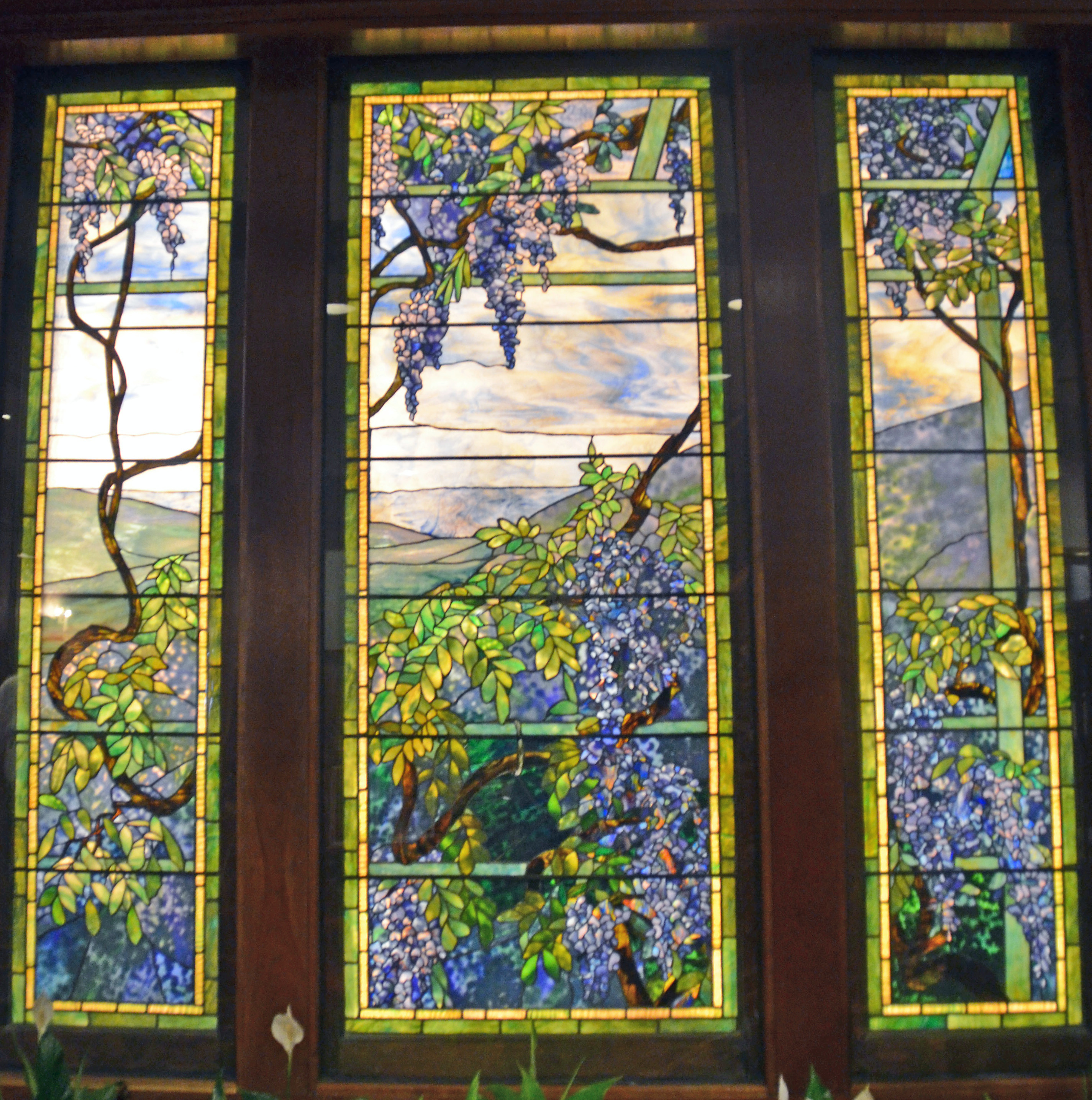
So to get back on track, my interest in Frank Lloyd Wright came not from one of his houses, but from his stained glass. My second reason for wanting to know more about this man and his works came from another unexpected source – T.C. Boyle‘s novel The Women which is a fictionalized account of Wright’s life with particular focus on his complex relationships with the various women in his life rather than his architectural works. It’s a great read and I highly recommend it to everyone who has the slightest interest in this, at times, egomaniacal American genius. Reason number three occurred this spring when I had an opportunity to visit the most famous of all Wright’s personal residences, Fallingwater in rural western Pennsylvania. This post is not about Fallingwater so I’ll just add a few pictures I took that day and admonish everyone to add this to their bucket list. It really does have a harmony with the surrounding stream and hardwoods that is astonishing.
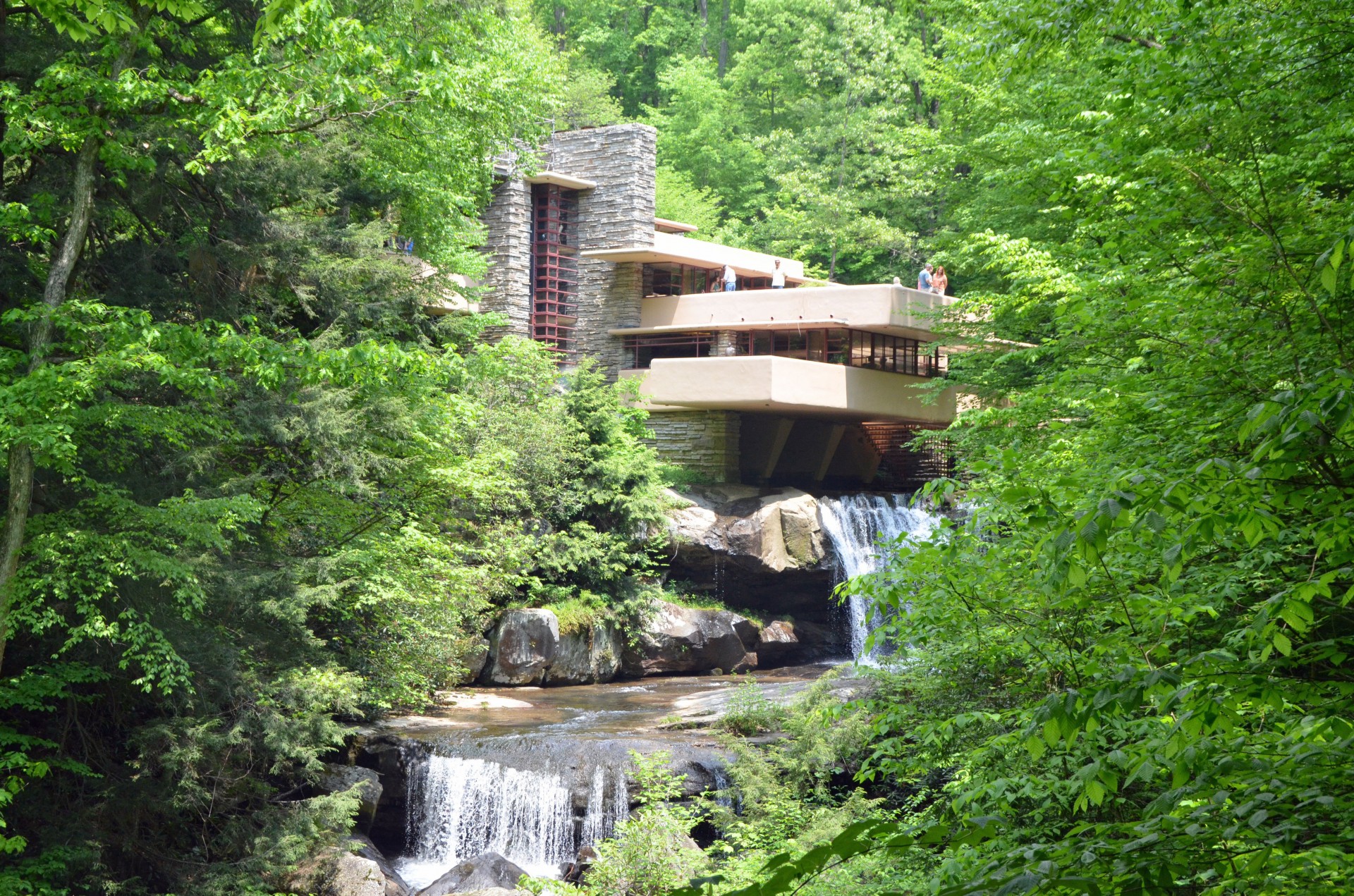
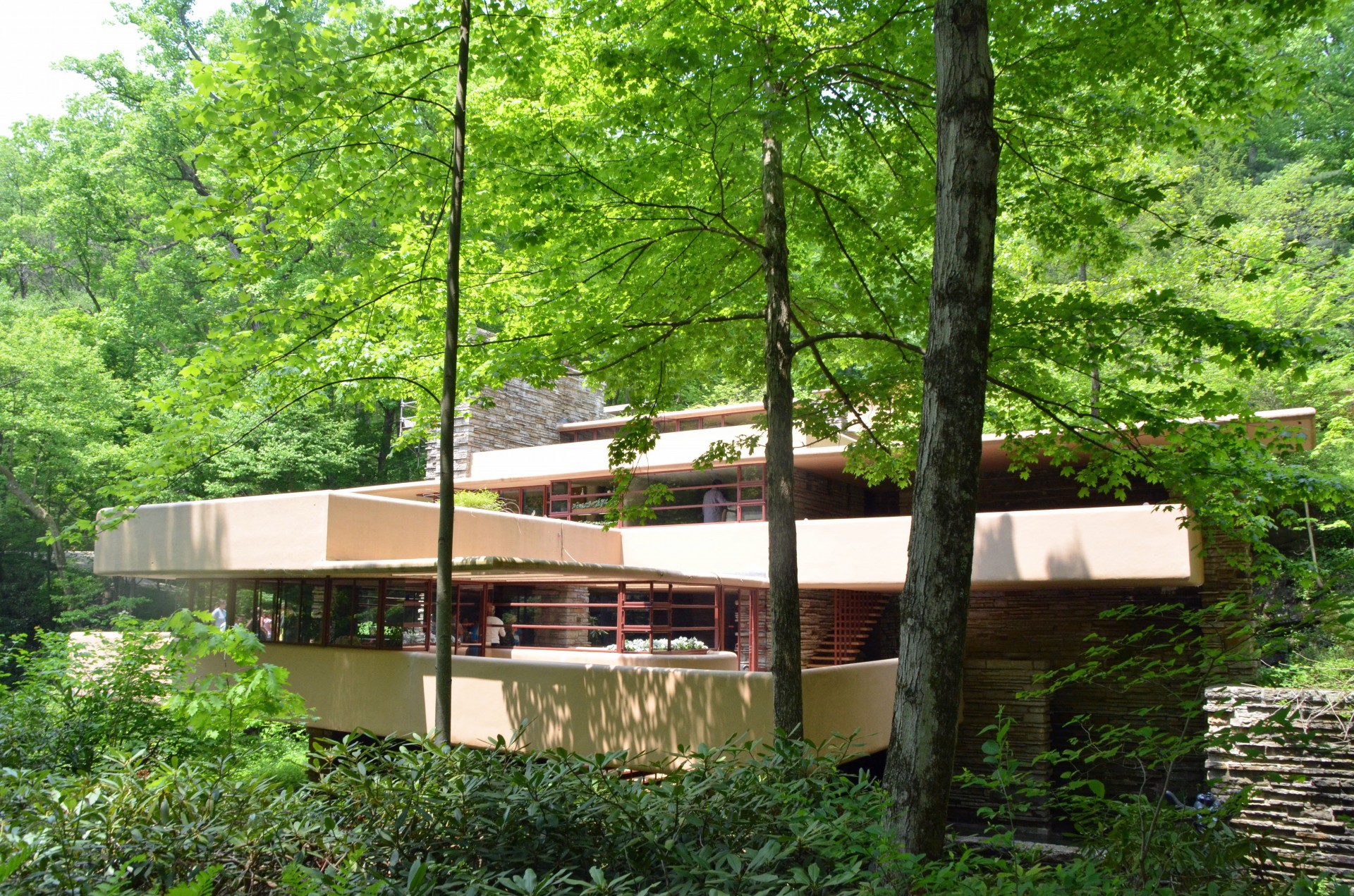
We also visited one other Wright house on this excursion, Kentuck Knob, which has a great location high on a hill overlooking the Laurel Highlands. It is a Usonian design, a term coined by Wright to refer to houses that he thought should be affordable for American middle class families. I wonder if he would be surprised that it is now owned by Lord and Lady Palumbo, hardly a typical middle class couple.

So fast forward and I am standing at the entrance to Austin Gardens, a small park at the end of Forest Avenue in Oak Park where all these great Wright houses are found in just a few blocks. There is this a bust of Wright, looking slightly like the Mad Hatter.
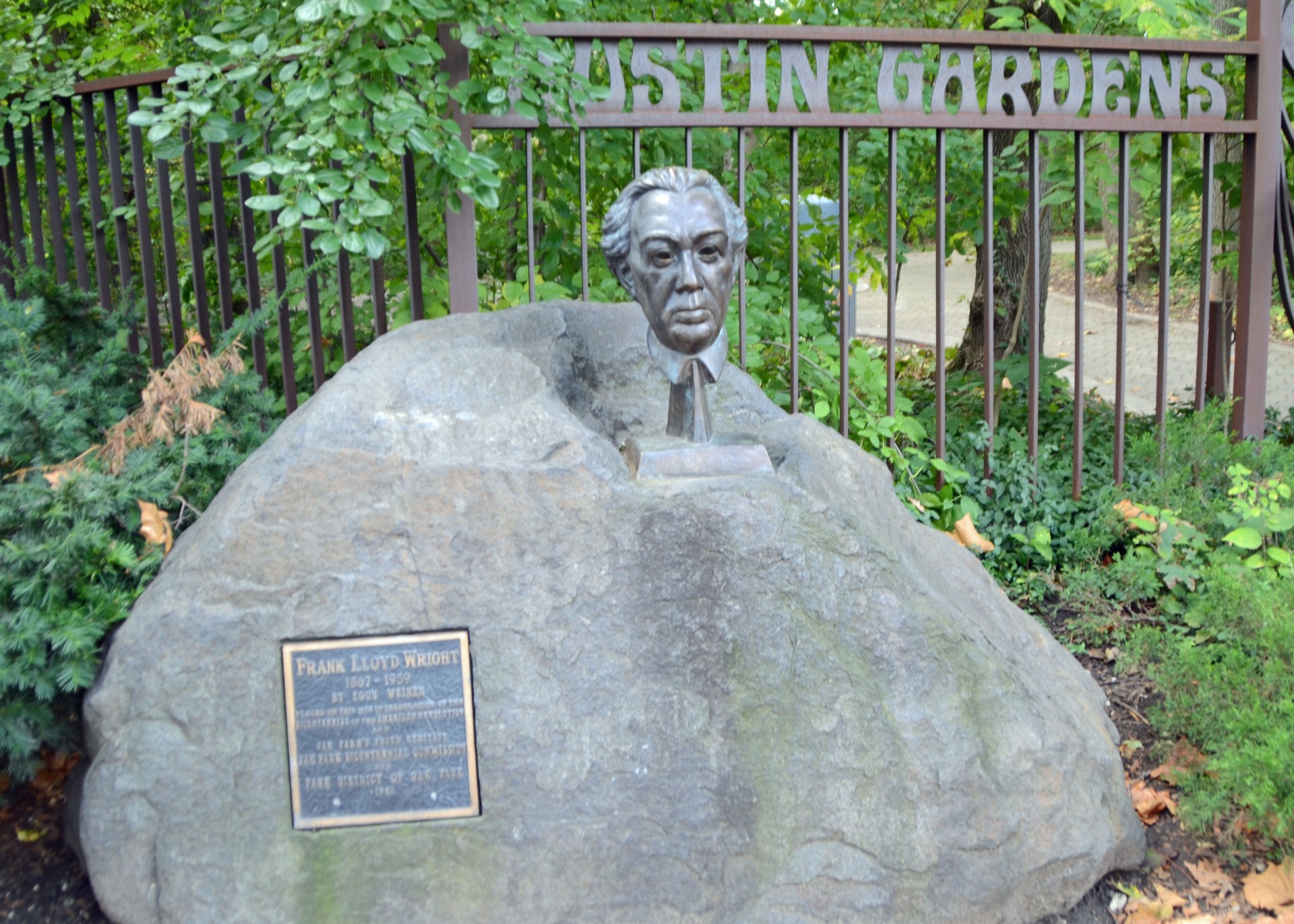
Heading for the Wright studio at the corner of Forest and Chicago I do notice that this is definitely an upscale neighbourhood with a lot of fine looking homes even without Wright designs. Here is a typical example.
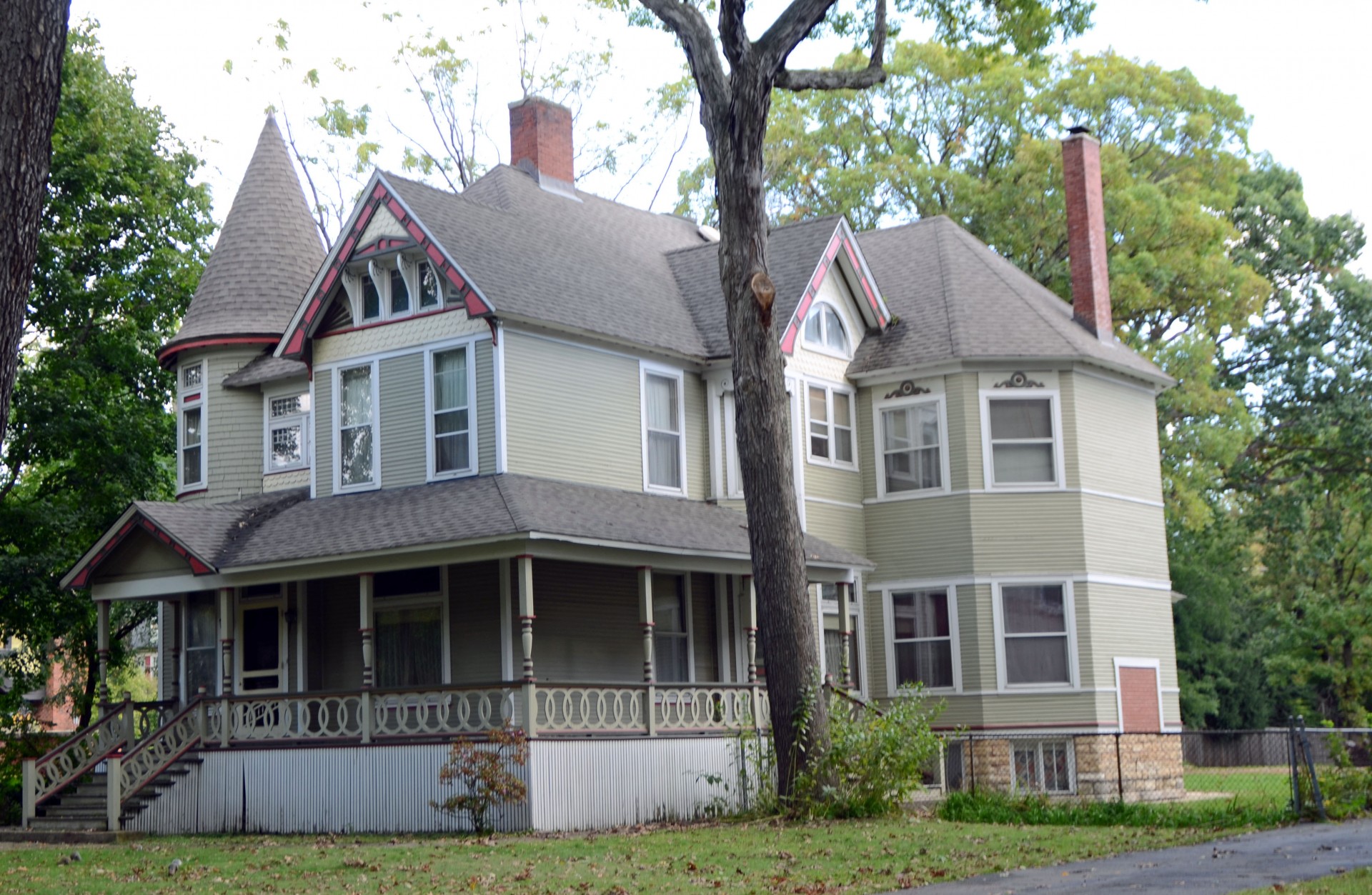
Wright’s studio and his home are in one large complex with the house facing Forest Avenue and the studio Chicago Avenue. The buildings, along with Unity Temple and two other Wright houses in Chicago proper are now administered by the Frank Lloyd Wright Trust. I decide the best way to get the most out of the visit is to take a tour of the studio first and then do the walking tour of the houses along Forest Avenue. The entrance fee includes a studio tour and if you want, an audio walking tour of the houses. The Wright house itself is not part of the tour and you can only view it from the outside. Tours seem to start every half hour, led by volunteers. The group I’m in has about twenty people. The entrance has these four stork columns that remind me of the caryatids at the entrance to the Erechtheion on the acropolis in Athens, don’t ask me why.
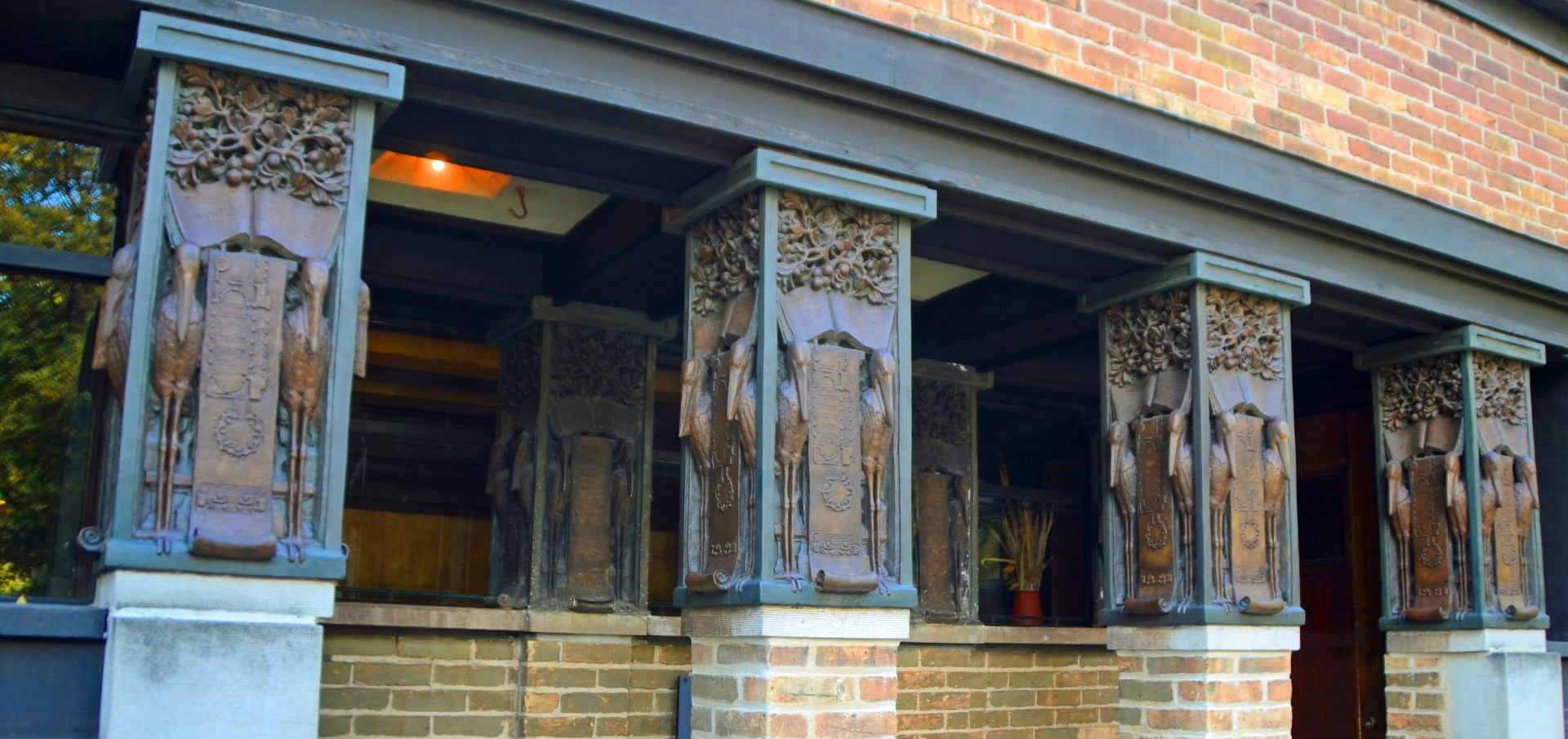
Also at the entrance is this rather modest sign proclaiming it to be the studio of Frank Lloyd Wright.
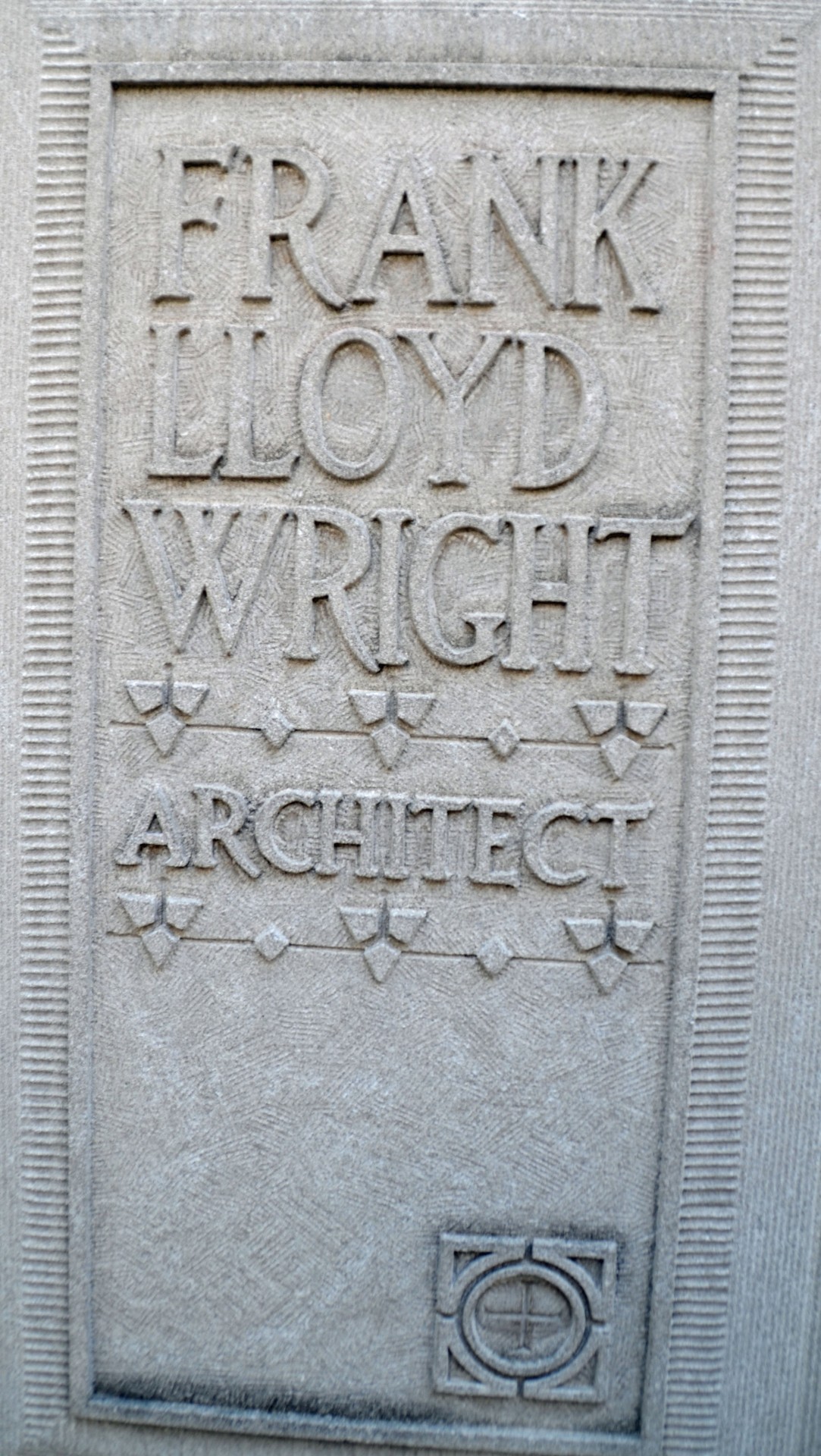
The interior is surprisingly dark and illuminated by artificial light for what I would have thought would be a profession that required natural light, but what do I know, maybe gloominess helped focus Frank’s thoughts.
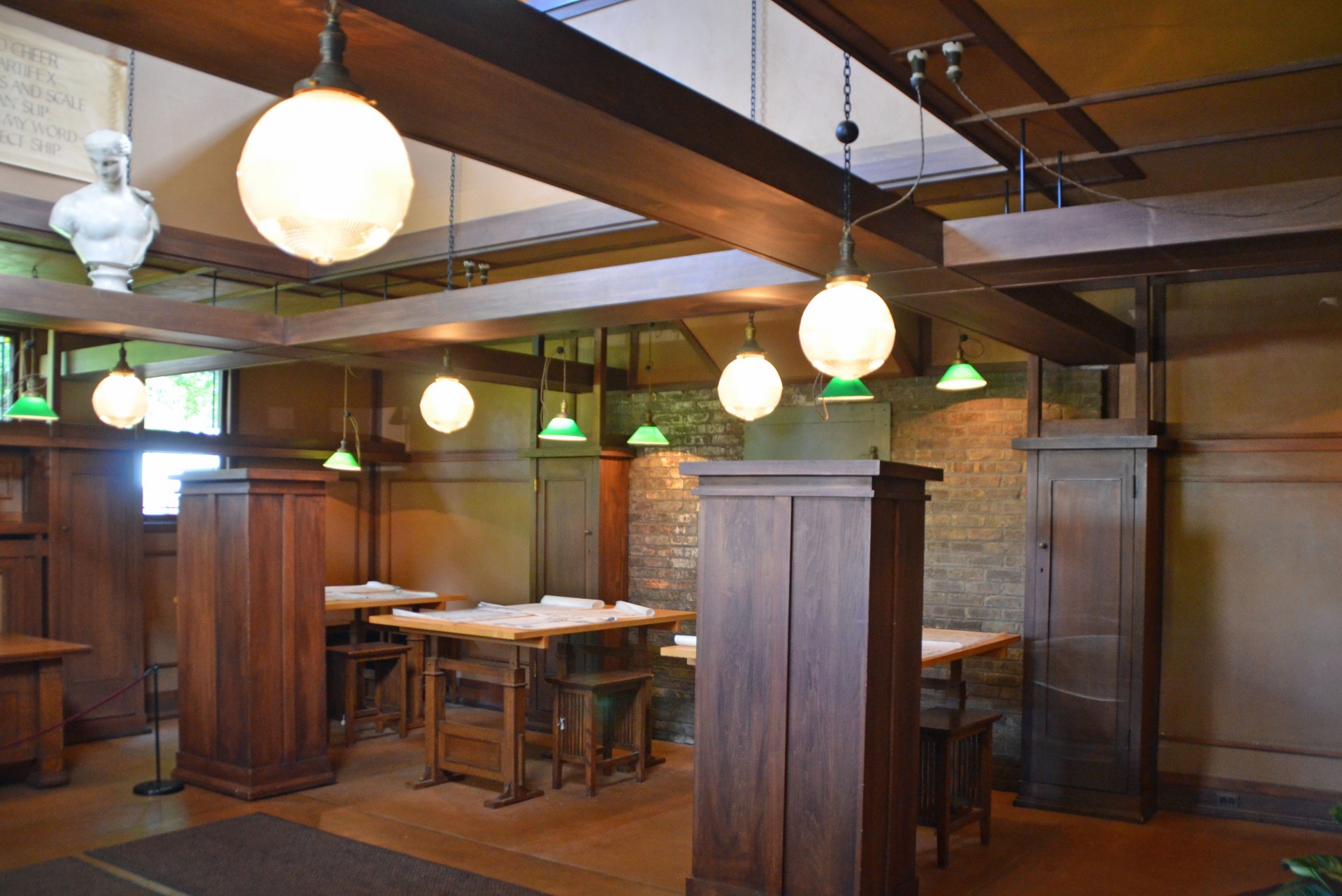
There are a number of original Wright architectural drawings still in their places on the tables, almost as if someone was expected to return and start working on them again at any moment.
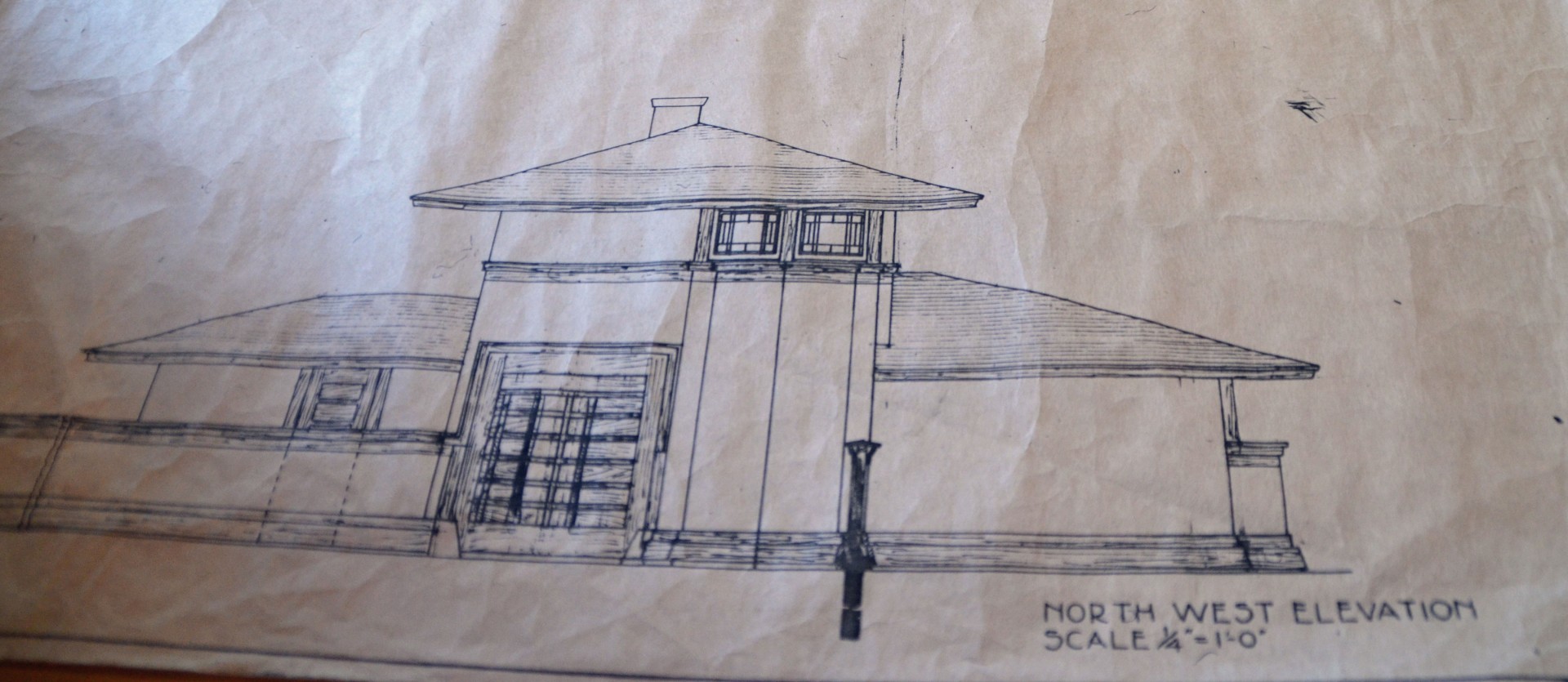
The most interesting feature is this octagonal ceiling that makes you realize that the drawing room, despite appearing to be all sharp angles, is actually an octagon.
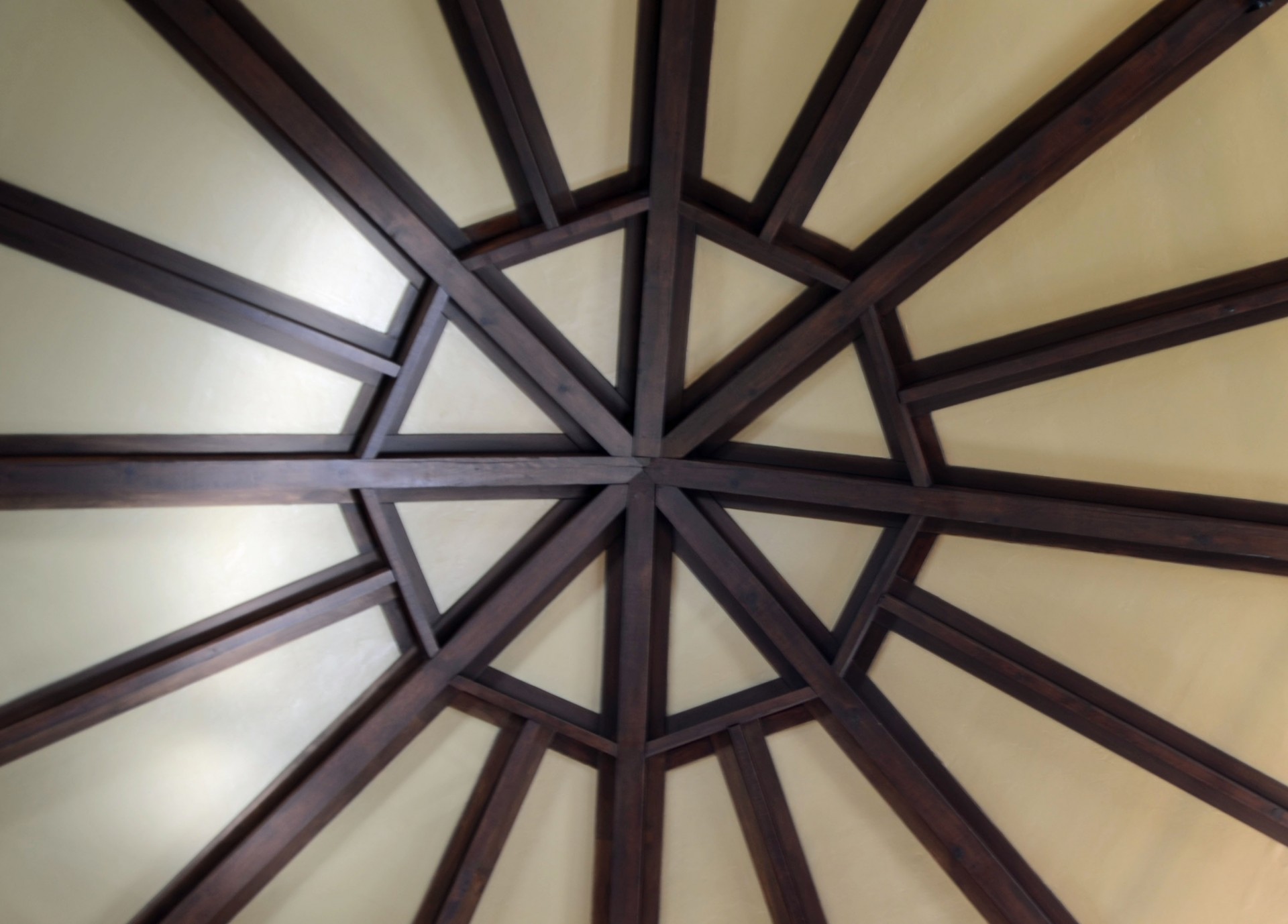
The tour continues through the reception area where there are some of the most uncomfortable looking wooden chairs imaginable; according to the guide intentional on Wright’s part as he didn’t want people just hanging around waiting to see him without an appointment. The entire tour doesn’t take more than twenty minutes and I can’t say it gave me any great revelations about Wright, but it was the proper place to start before heading out to Forest Avenue which I do after picking up the audio guide. I will not try to describe each of the Wright houses, but will provide links if you want to learn more specifics on each house. First up is the Wright home which is probably the most traditional looking of any of the Wright homes in the area.
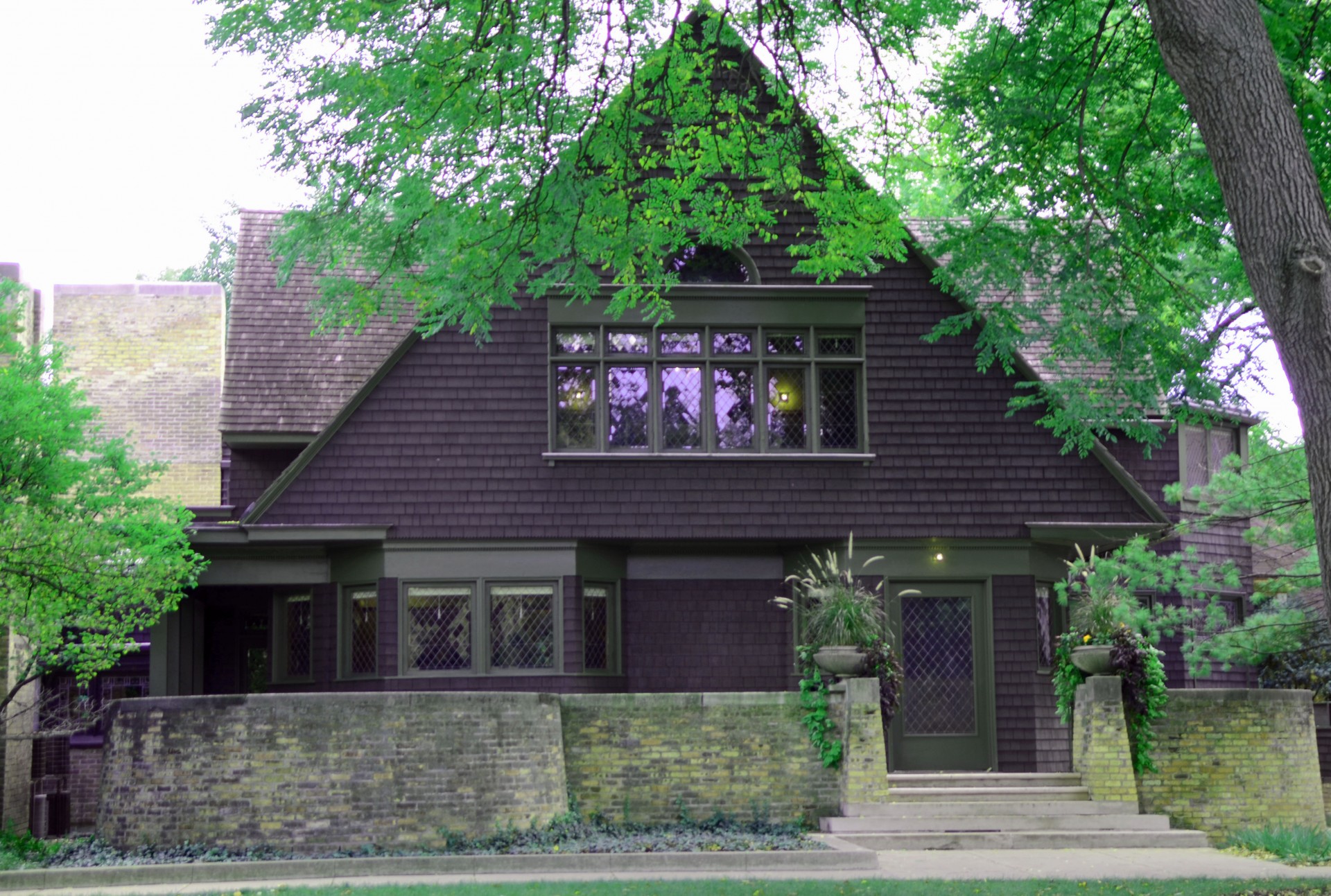
Next is Arthur Heurtley House, definitely more my idea of a Wright design.
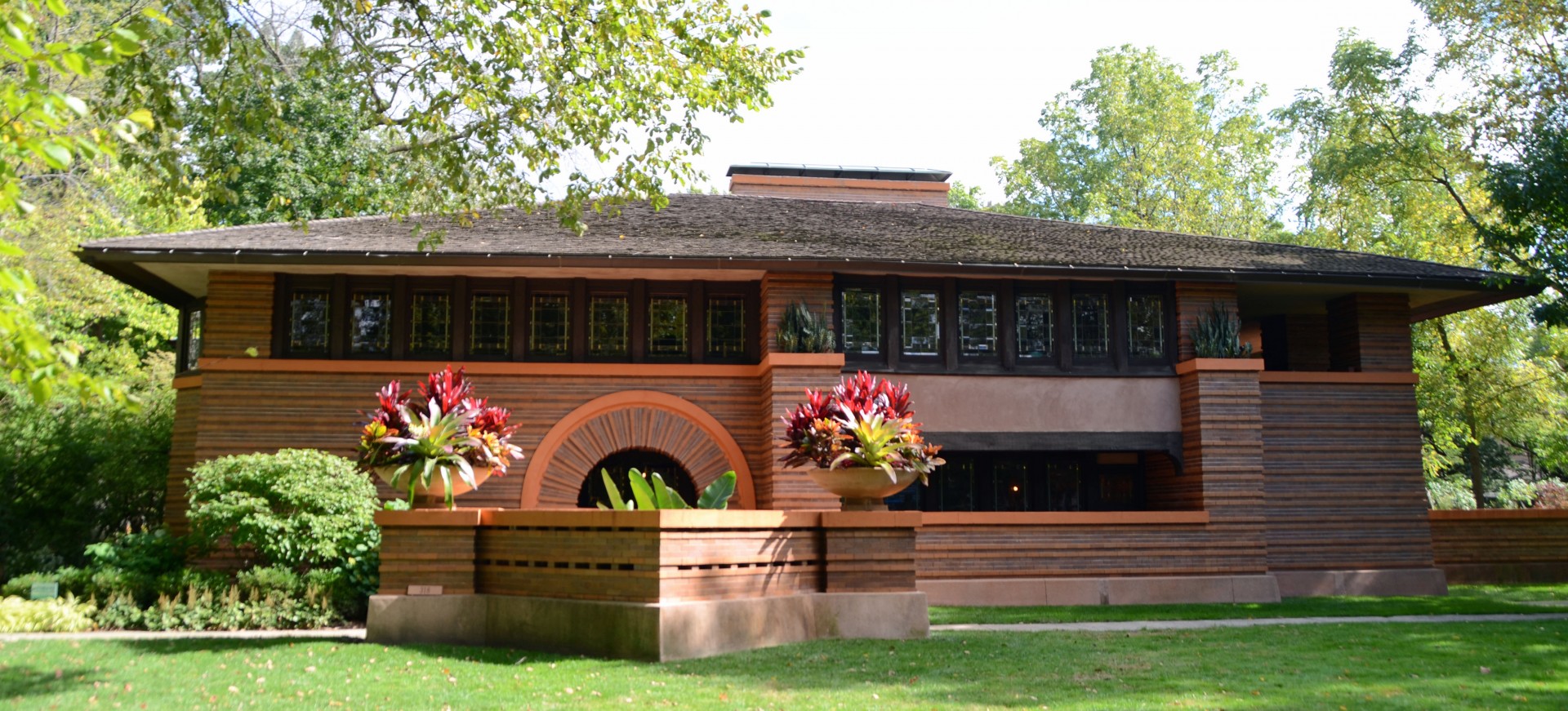
Then the Laura Gale House, which didn’t do much for me. It’s actually stuck on a fairly small lot compared to the rest that have huge lots so you can get an appreciation of them from a number of angles.
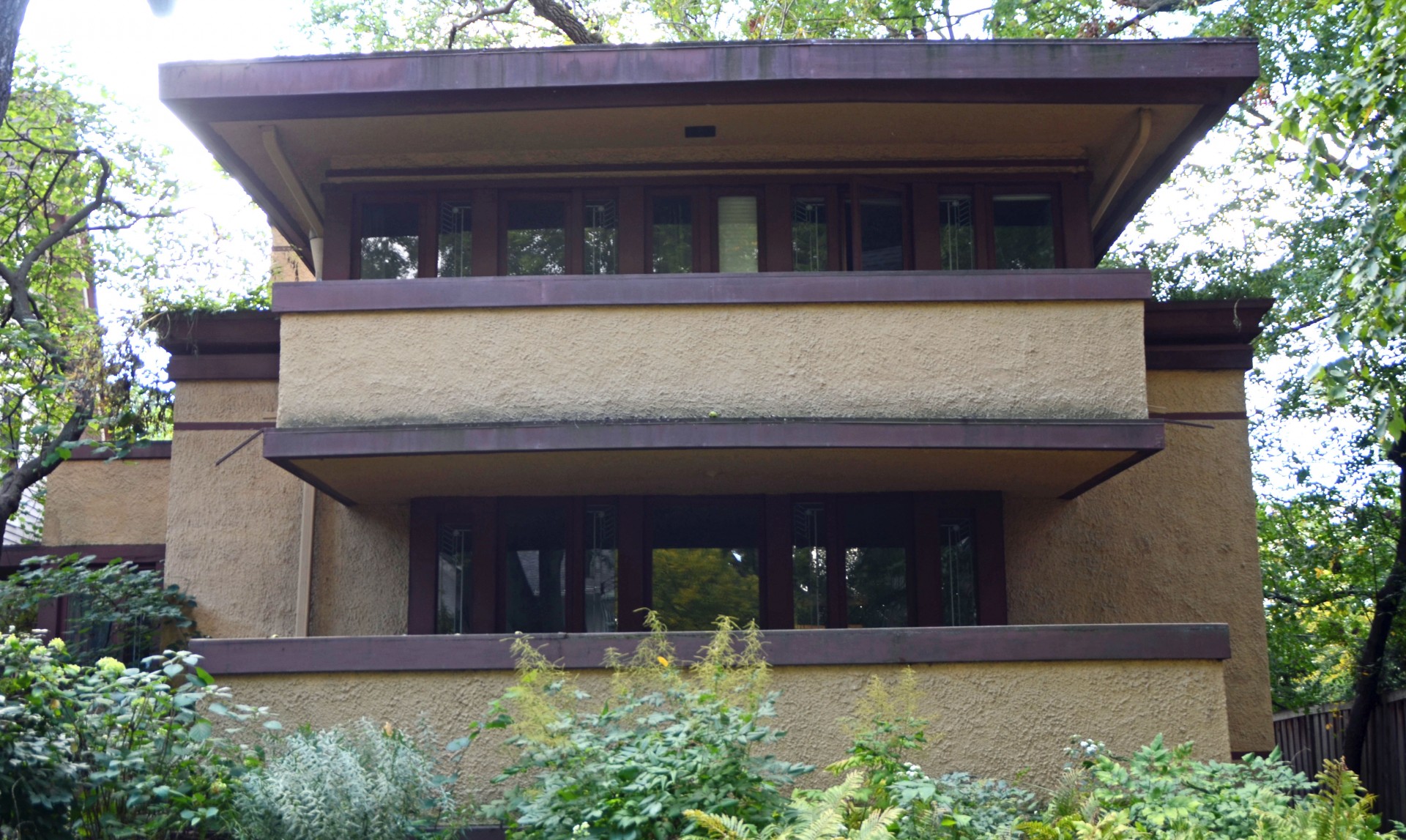
Number three is the Peter Beachy House which is actually a Wright redesign of an older home. It is a stunner from all angles and clearly presages Wright’s incorporation of Oriental themes in his work.
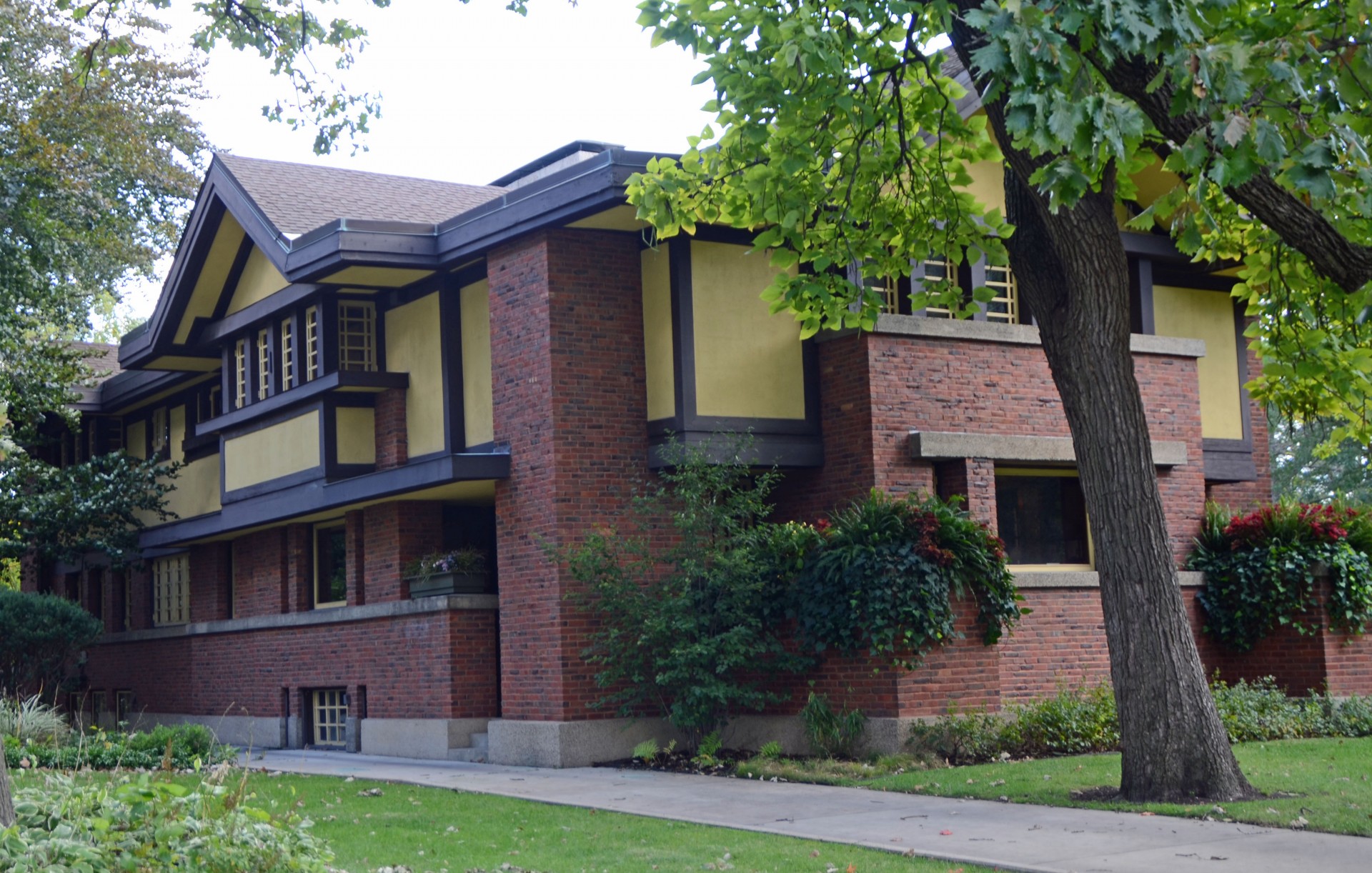
Next is the Frank Thomas House, not the Chicago White Sox Frank, but another one. Built in 1901, Wright called this his first Prairie School design.
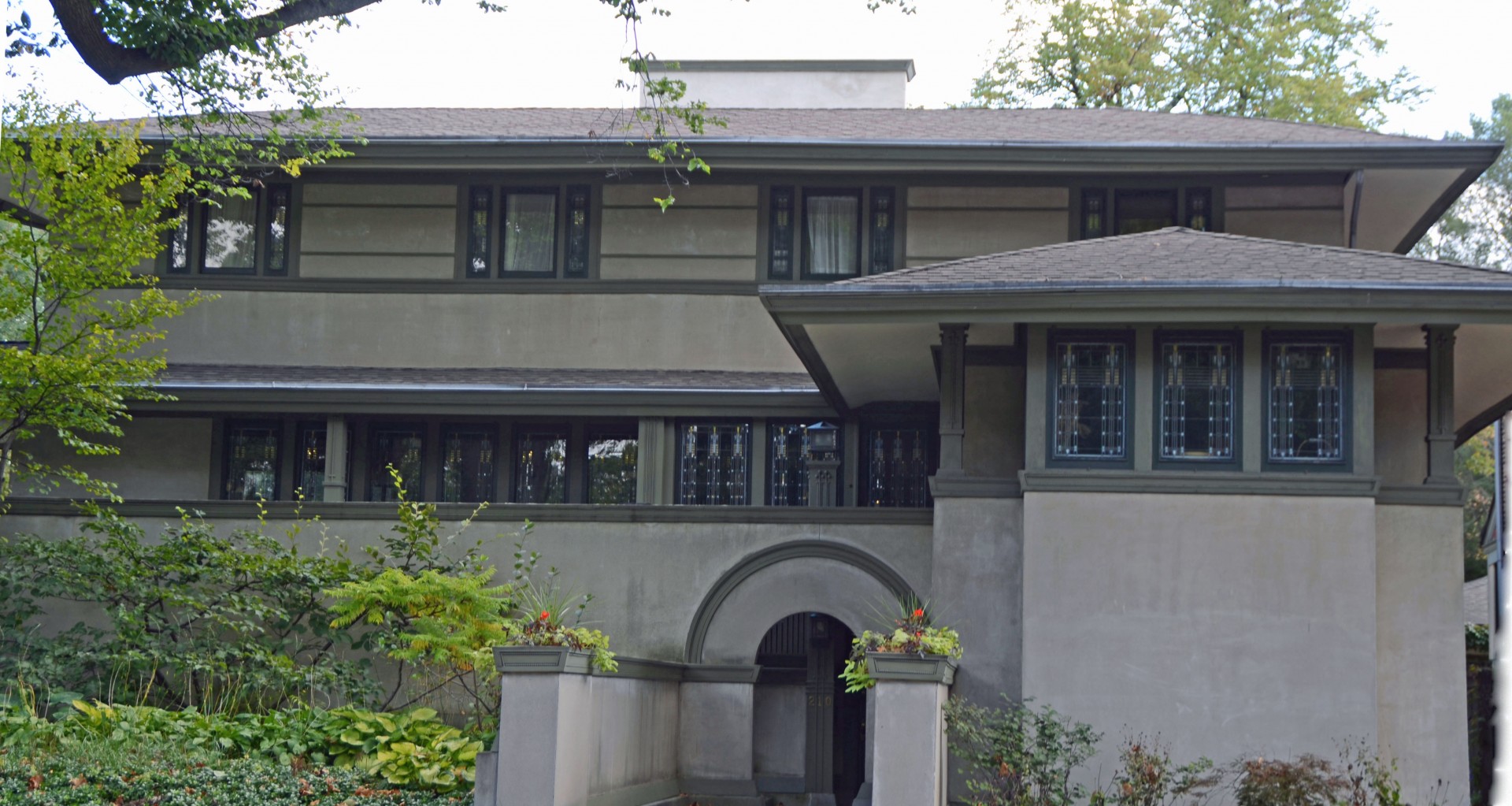
Crossing to the odd numbers on Forest Avenue you come to the Hills-Decaro House which warrants two pictures.
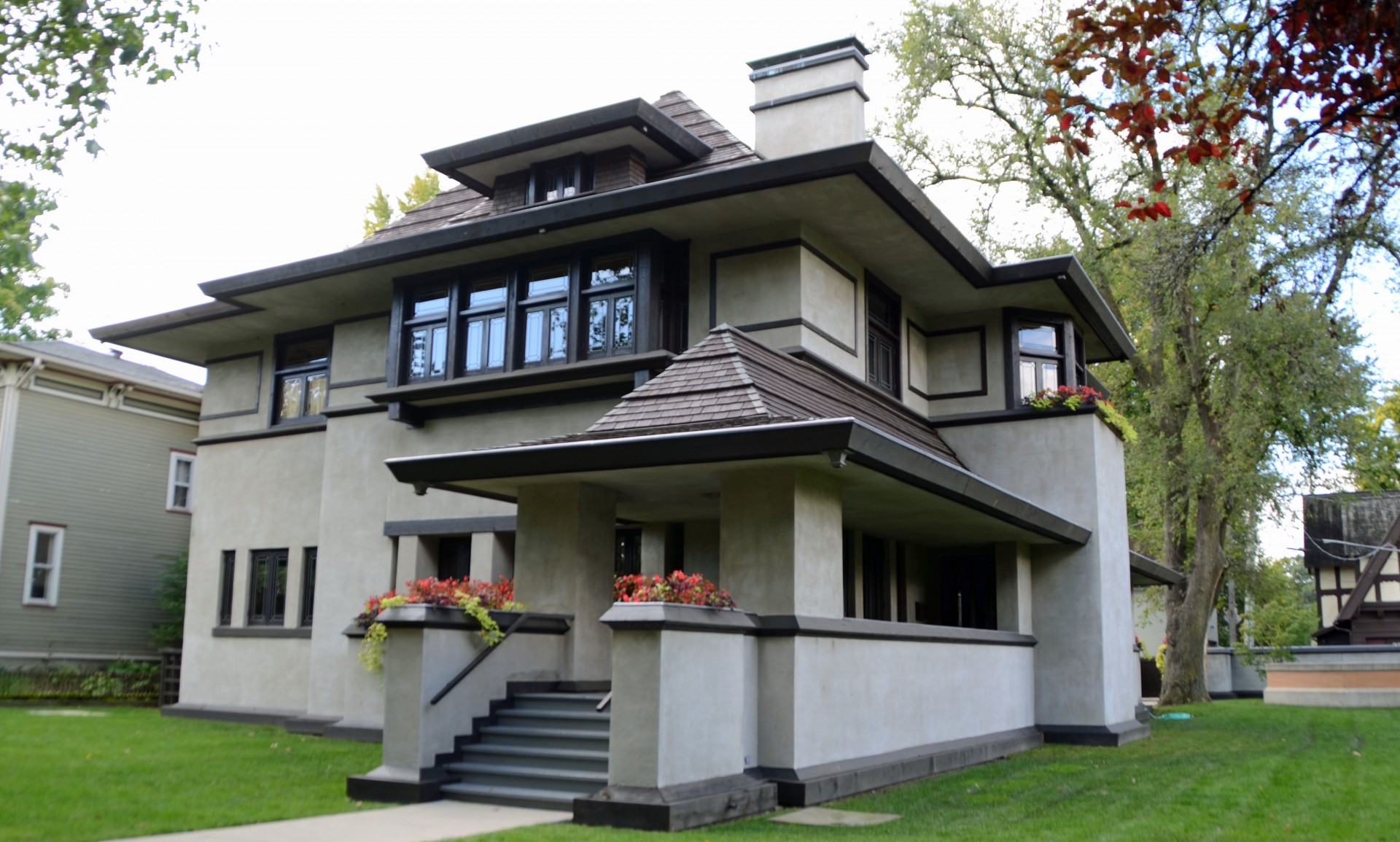
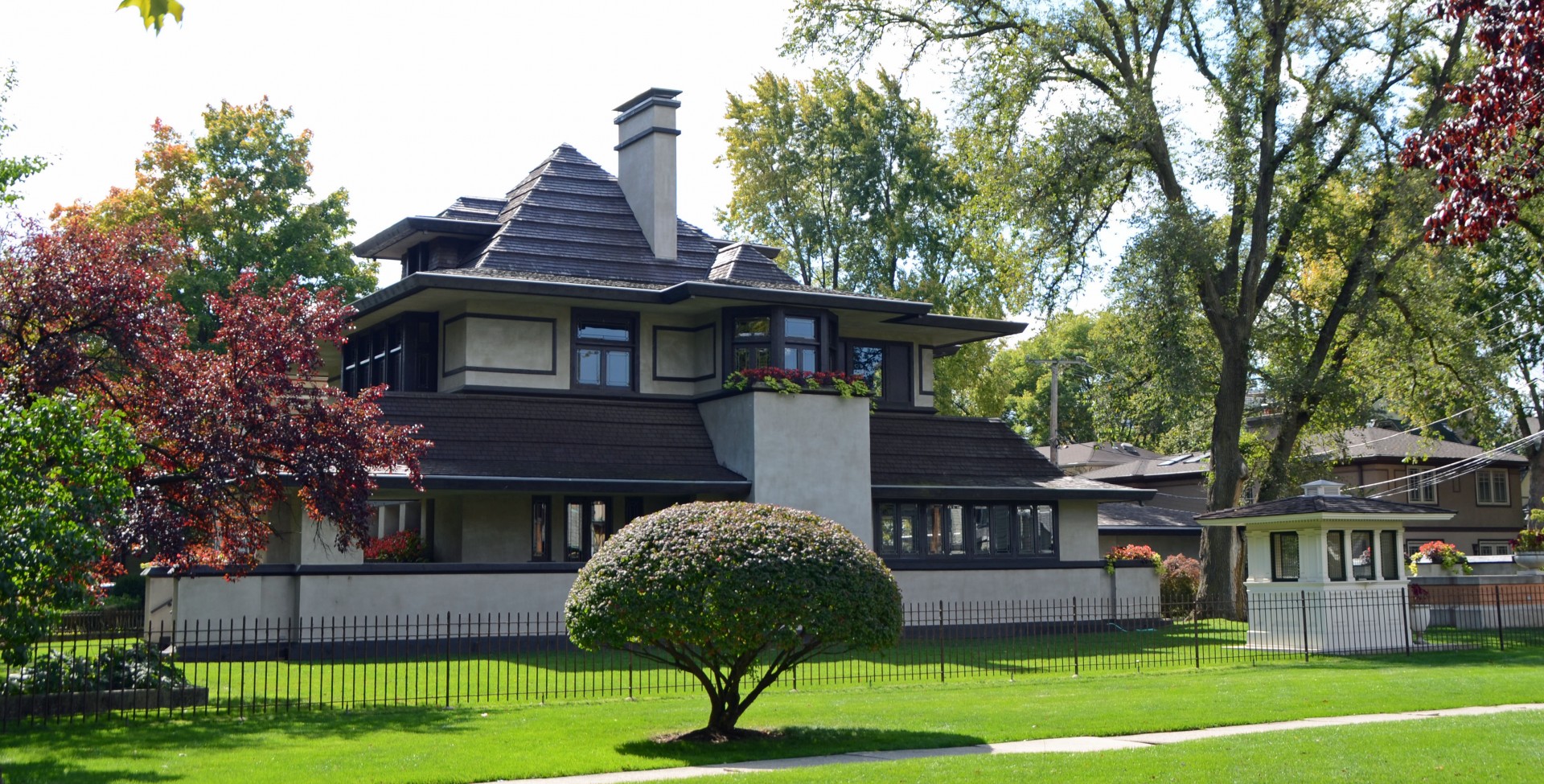
Last and definitely not least is my favourite of the lot, the Nathan G. Moore House which also deserves a look from more than one angle. All these amazing houses in just over one block from Wright’s studio. All I can say is “Wow!”
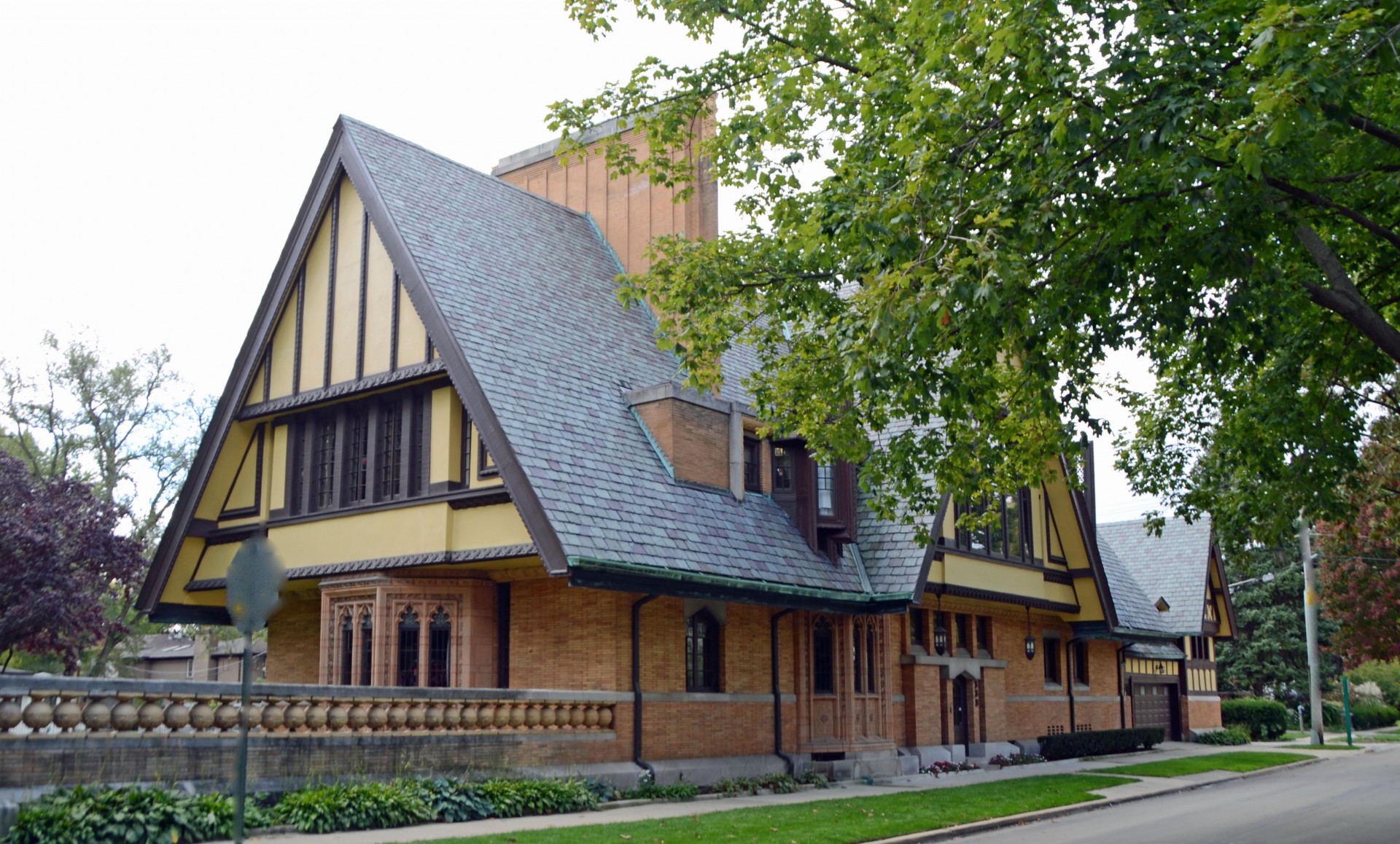
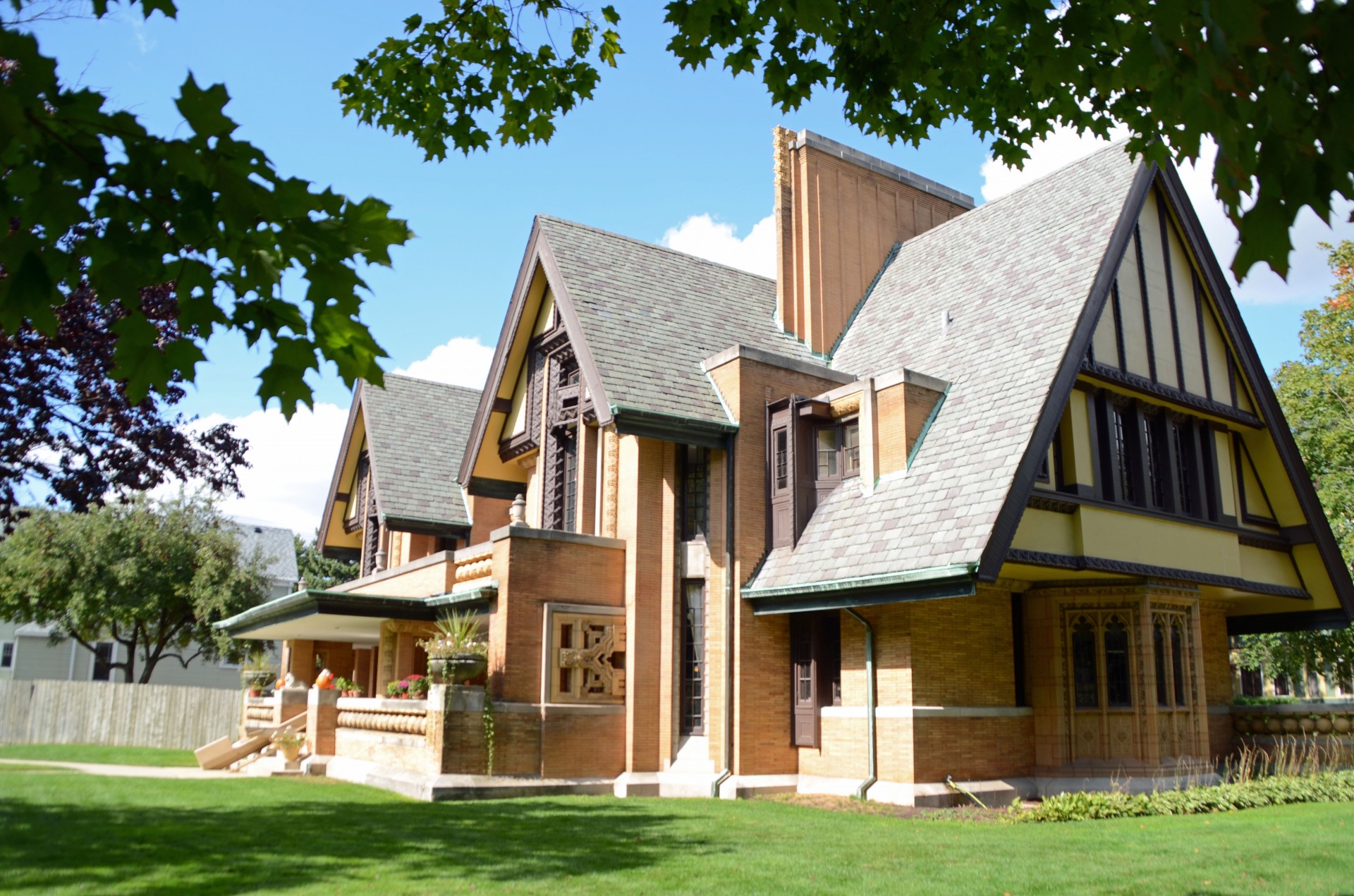
So that’s it for Frank Lloyd Wright in Oak Park – time to get some lunch.
I noticed a decent looking place in Scoville Square called Winberie’s and walked the short distance back from Forest Avenue. They had lake trout as the special and I couldn’t pass that up. The last time I had lake trout was probably forty years ago and it would have been one I caught in Clearwater Lake, outside The Pas. It is not a fish that has been successfully farmed so it was good to know that this was the real deal – a wild fish. When you think about it how many things do you get to eat these days that are not farmed in one way or another? Not many. To top it off, it was truly excellent and matched perfectly with the beurre blanc sauce that came with it.
UPDATE: Sadly Winberie’s closed in 2019 after decades of service to the people of Oak Park.
Feeling great I walked the few blocks to Ernest Hemingway’s birthplace at 333 North Oak Park Avenue and found out that in order to get in I had to buy a ticket at the Hemingway Museum just down the road which I did..
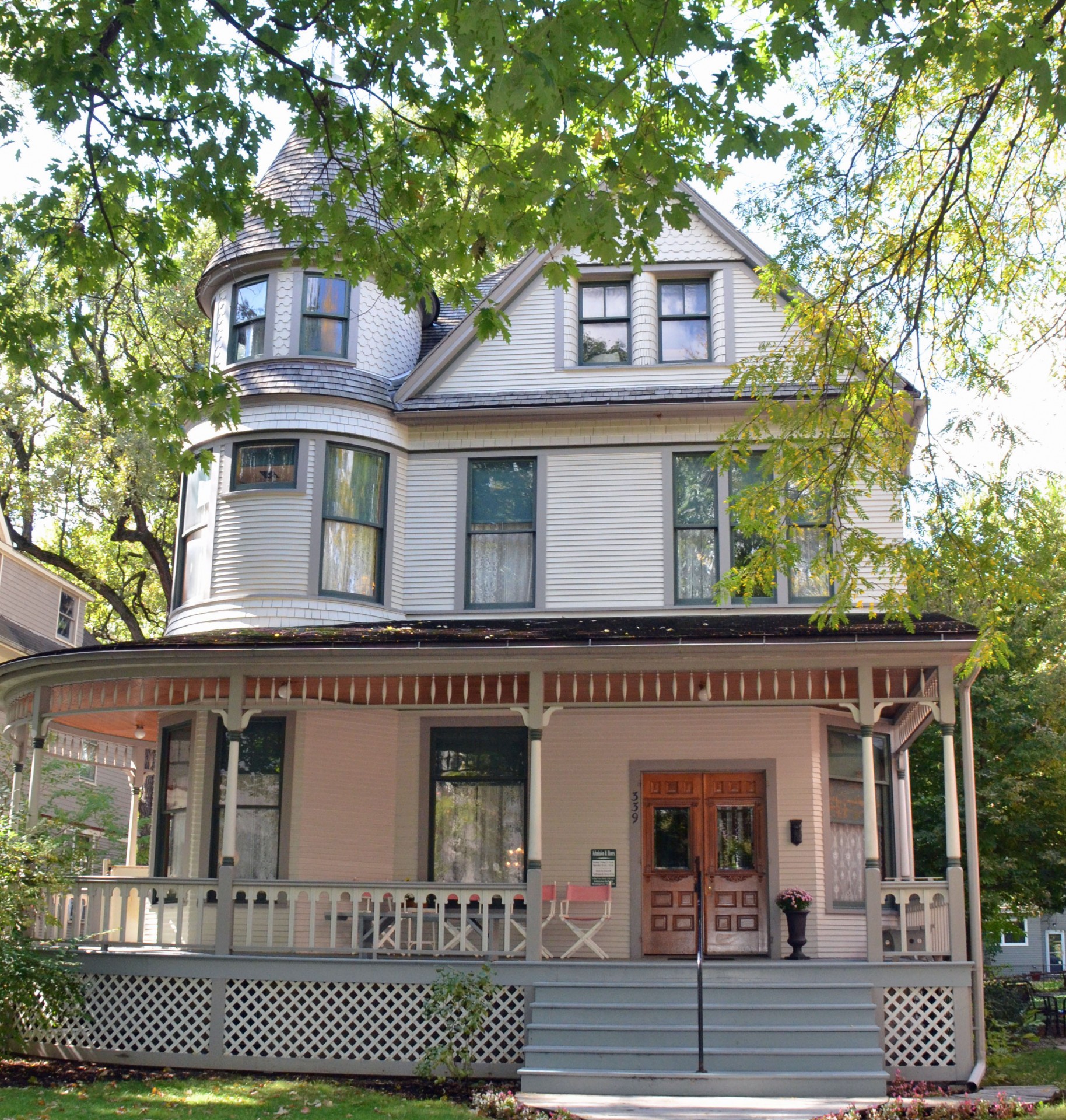
It was located in the basement of this building which apparently is the Oak Park Arts Center, although I saw nothing there other than the museum.
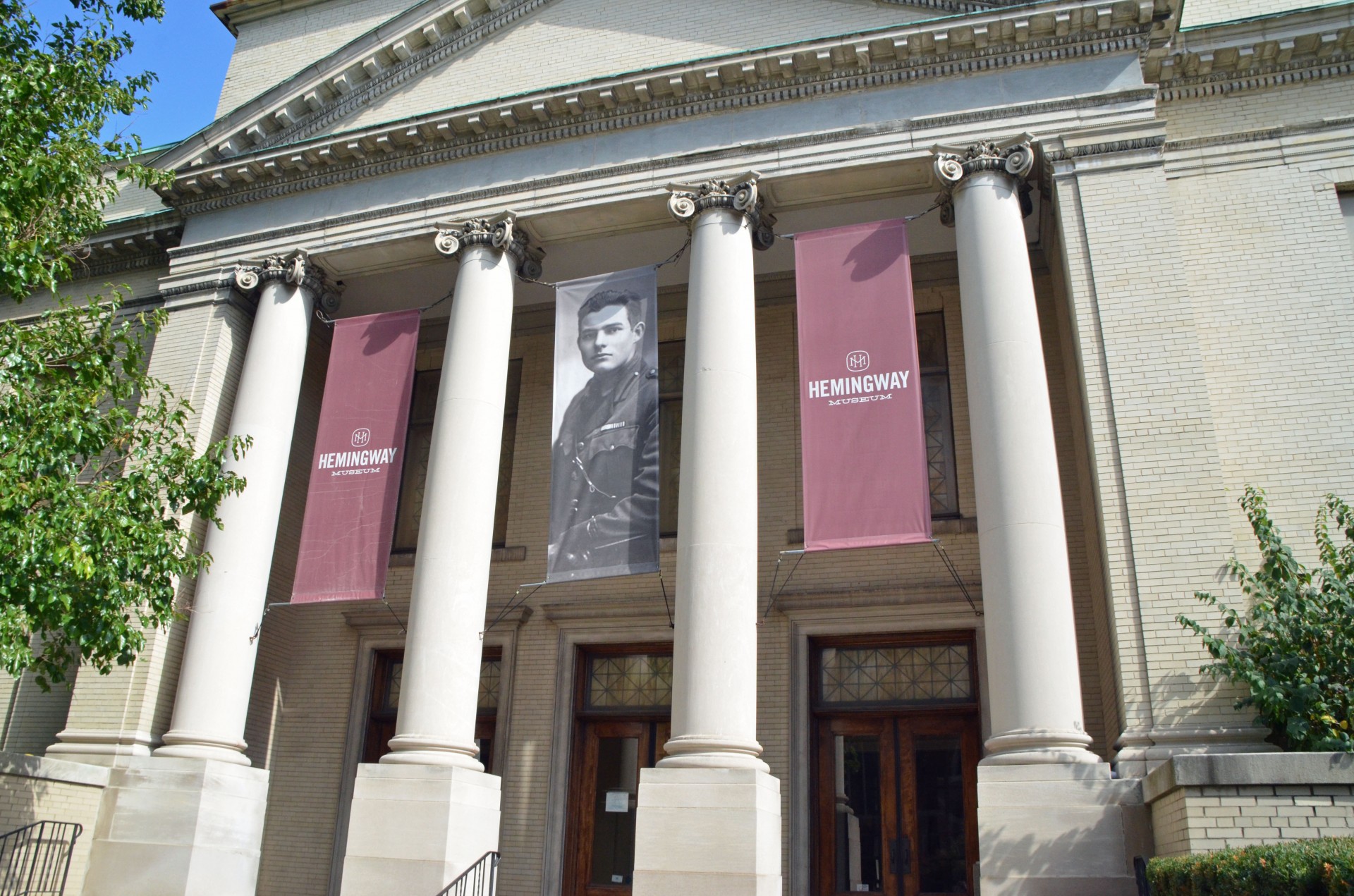
Of all the great American writers of the 20th century, none has had the impact on me that Ernest Hemingway did. By the time I was twenty I had read all his best works and was truly mesmerized by his writing style. Who else could write something as simple as “It was good.” and not need to elaborate? He taught me the difference between love and carnality, bravery and foolhardiness, zest for life and sensuality. Wherever Ernest had gone I wanted to go. Here I am with him in Pamplona where he ran with the bulls.
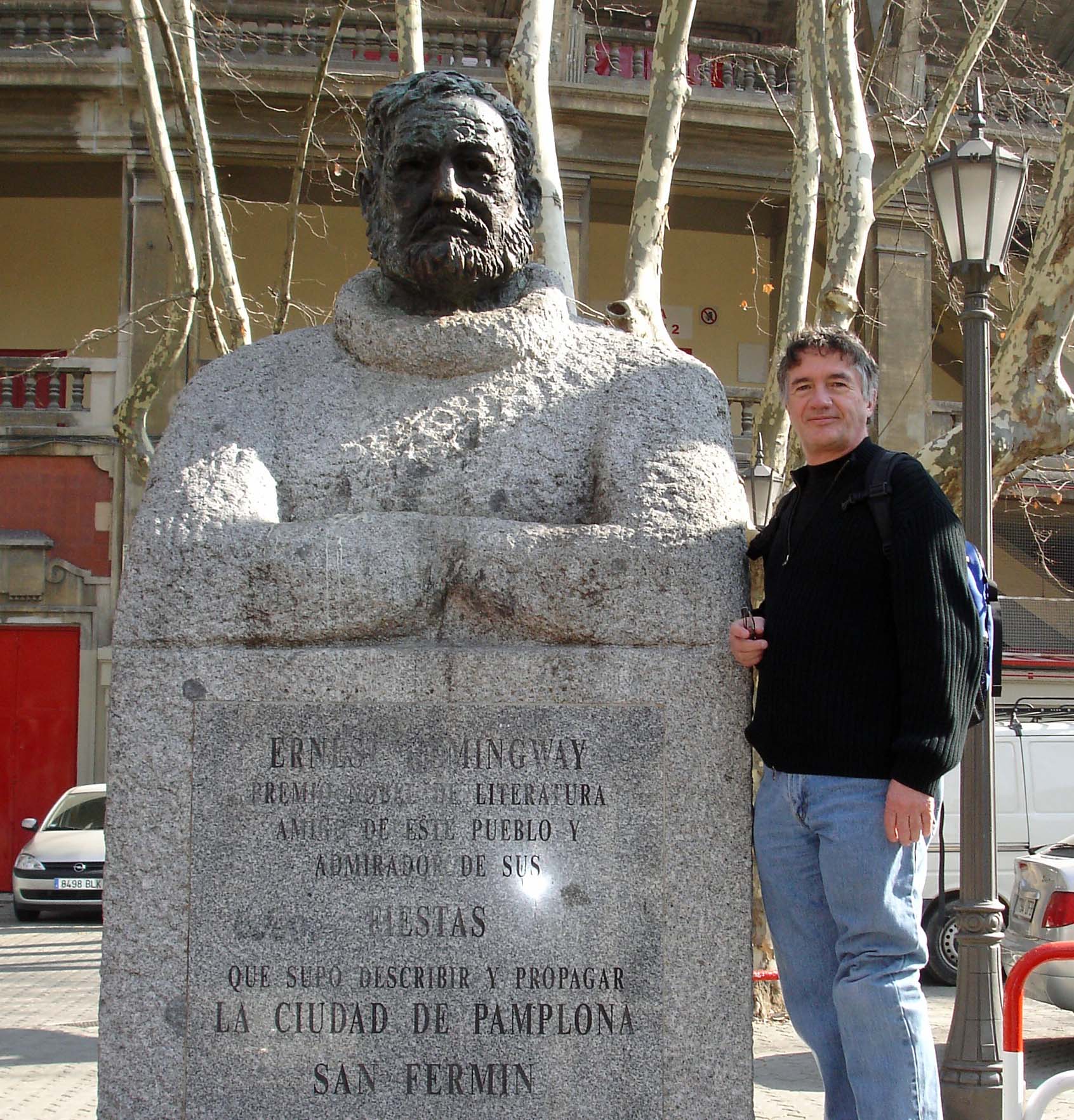
And in Key West where he wrote some of his greatest novels, caught fish and drank like one at Sloppy Joe’s.
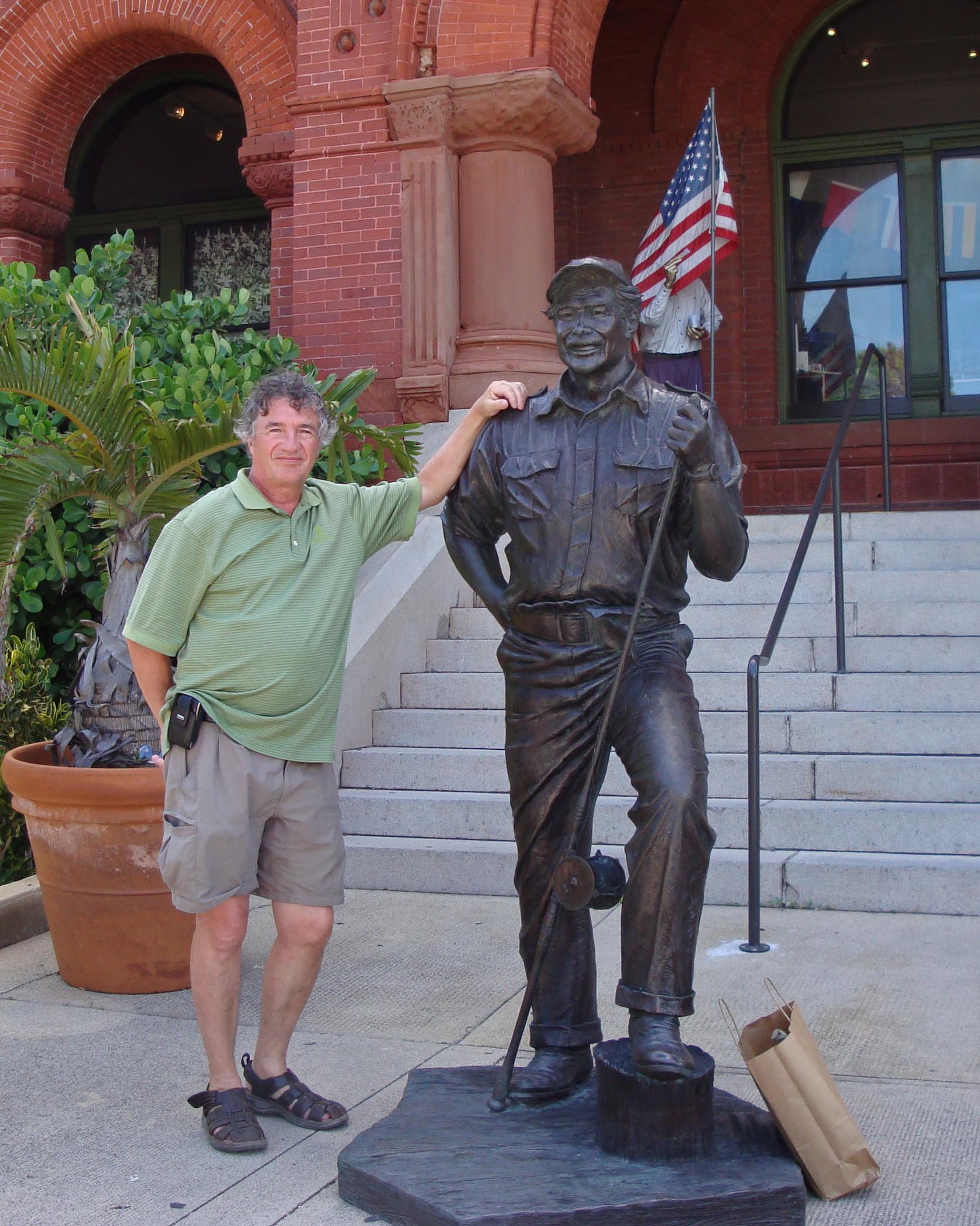
So I was psyched to be in his home town and really looking forward to the museum and home tour. I’m sorry to report that the museum was a huge let down. There was next to no original material, the organization didn’t seem to follow any logical pattern and the elderly lady who was apparently in charge treated visitors as if they were rubes who had never heard of this guy Hemingway, before happening to stumble on this place. While well meaning, her constant interruptions to describe in her own words exactly what was written on the displays was an annoyance. I didn’t stay more than twenty minutes and decided to forego the home because I expected it would be a let down as well since it was administered by the same not for profit group. The fact I didn’t take a single picture inside the museum speaks for itself. This might not be charitable, but I suspect the reason Ernest left Oak Park at such a young age to volunteer in WWI was to get away from the very type of people who now keep his memory alive at the museum.
Anyway, although the Hemingway visit was a disappointment the overall day was, to paraphrase Ernest, ‘good’.
For another post on Frank Lloyd Wright, read this one on Lakeland, Florida which has the largest collection of Wright buildings anywhere at the campus of Florida Southern University.
For more enlightening posts on Hemingway read these – Hemingway in Paris, Hemingway House in Key West, Hemingway in Idaho, or even the Hemingway Hotel in Nairobi.

